Transportation News
Pettus named executive director of Auburn University Applied Research Institute in Huntsville
Auburn University’s Office of the Senior Vice President for Research and Economic Development has hired Jonathan Pettus as executive director of the Auburn University Applied Research Institute (AUARI) in Huntsville, effective February 1.
Pettus previously worked for 27 years at NASA, where he served in a variety of executive leadership roles including as NASA’s chief information officer and as the associate director of Marshall Space Flight Center. Before joining the Auburn family, he retired from Dynetics/Leidos, where he led a business unit that included programs in space, hypersonics and cybersecurity solutions.
Beginning his career as a high school mathematics teacher and basketball coach, Pettus grew up “intrigued and enthusiastic about space” and technology, he said. Pettus noted he is “excited about the opportunity to help with the overall strategic goal of continuing to grow Auburn’s impact in applied research” and sees a “great opportunity” at AUARI to grow research efforts aimed at solving real-world problems.
“The Applied Research Institute will be in capable hands with Jonathan Pettus as its executive director,” said Steve Taylor, senior vice president for research and economic development. “He brings to the position a wealth of knowledge and experience in the aerospace, defense and advanced technology sectors. I am confident he will help us expand critical applied research efforts that will address important challenges from our government and industry partners.”
The Auburn University Applied Research Institute operates within the Auburn University Research and Innovation Campus in Huntsville's Cummings Research Park near the Redstone Arsenal, a 38,000-acre federal research, development, test and engineering center. The Institute brings together Auburn faculty, research professionals, and students to conduct cutting-edge applied research and development across a range of technology readiness levels to help customers overcome aerospace, defense, national security and biotechnology challenges.
Media Contact: Jeremy D Henderson, jdh0123@auburn.edu, 334-844-3591

Jonathan Pettus has been named executive director of the Auburn University Applied Research Institute. [Credit: UAH]
Categories: Transportation, Engineering, Manufacturing, OSVPRED
Auburn rocket plume research to aid future spacecraft landings
Landing a space vehicle on an interplanetary body has always been a tremendous challenge. In most cases, powerful retrorockets must fire at just the right moment — with just the right amount of thrust — to slow the vehicle sufficiently to prevent damage and successfully deliver the payload to the target’s surface. That’s why touchdown is always a hold-your-breath moment for the scientists and engineers involved.
Even so, landing successfully is only one part of the battle. The other part is ensuring the dust and debris kicked up by the retrorocket’s thrusters do not damage the vehicle itself or any other important hardware nearby. But a team of Auburn researchers are working to reduce some of the stress during landings by studying these thruster-induced plume-surface interactions (PSI) to better predict their outcomes.
David Scarborough, an associate professor in the Department of Aerospace Engineering at Auburn University, is the principal investigator for two NASA grants — one for $538,789 and a second for $650,000 — to study PSI, along with a team that also includes co-investigators and fellow faculty, associate professor Vrishank Raghav, assistant professor Nek Sharan and the W. Allen and Martha Reed Professor and department chair Brian Thurow. In addition, the research team also includes postdoctoral fellow Vikas Bhargav and graduate students, Murphy Mitchell, Srijan Satyal and Brandon Fulone. In the past, graduate students, Trevor Crane, Daniel Stubbs and Lokesh Silwal were also actively involved in the experimentation work.

Graduate students Trevor Crane (kneeling) and Daniel Stubbs (standing over the equipment) conduct experiments aboard the "Vomit Comet.
NASA’s interest in PSI dates back as far as the lunar missions of the Apollo Program in the 1960s. Research into the issue gained urgency after the Apollo 12 mission in November 1969. On that mission, the lunar module set down adjacent to the lander from a previous 1967 unmanned mission called Lunar Surveyor Three, which had sent back data critical to planning the Apollo landings. The Apollo 12 astronauts brought back pieces of the Surveyor craft, which showed pitting and scorch marks caused by the retrorockets fired during the lunar module’s descent.
With NASA now planning a return of manned missions to the moon in the near future, better understanding plume-surface interactions will be critical to ensuring such damage can be predicted and perhaps mitigated.
“In the next decade,” Scarborough said, “NASA is prioritizing returning humans safely to the moon, deploying scientific instruments on a variety of extraterrestrial bodies and ultimately enabling human exploration of Mars. One of the most significant obstacles to achieving these objectives is our limited understanding of plume-surface interactions leading to crater evolution and dust formation during descent and touchdown.”
In order to improve our understanding of PSI, experimental facilitates have been constructed in the Auburn University Combustion Physics Laboratory (AUCPL) to emulate conditions of extraterrestrial environments that future landers might encounter.
For instance, the vacuum-chamber experimental facility is used to simulate lunar atmospheric conditions, while the drop-tower facility can generate reduced gravity conditions. These facilities were used to record the crater evolution and track ejecta particles using high-speed cameras, to investigate the effects of the thruster operating conditions and the ambient environment.
In spring 2024, Crane and Stubbs took the research even further, designing and conducting experiments on board NASA’s modified Boeing 727 aircraft — nicknamed “the Vomit Comet” — that flies parabola patterns designed to briefly produce lunar, Martian and zero-gravity conditions.
“Depending on the angle at which the plane falls, different gravity levels are simulated inside the cabin,” Crane explained, noting that the aircraft really lives up to its nickname. “In the airplane, we are able to run our PSI experiments in simulated Martian, lunar and micro-gravity conditions. Research using the parabolic flights is ongoing, with future flights planned to gather more data.”
In the recent past, NASA also conducted an experimental campaign called physics-focused ground tests to fundamentally characterize plume-surface interactions. These tests generated substantial datasets, which require a long-term, dedicated effort to deduce important physics involved in the interactions. The team at Auburn also aims to leverage the experimental and numerical capabilities in-house to facilitate the development and validation of predictive tools using the datasets generated by NASA.
Eventually, the team hopes to provide NASA with data that will allow the space agency to confidently predict and make allowances for plume-surface interactions on the moon, Mars and beyond.
“The overall goal of our PSI research is to be able to develop physics-based models for rocket landers that can be used for future missions,” Scarborough said. “These models will be able to relate to parameters like rocket size, engine thrust and dust or particle size of the planetary surface to predict the cratering and debris effects caused by a lander. Future simulations will be able to use these models to better inform lunar and Martian missions and reduce the risks associated with their landing vehicles.”

David Scarborough, an associate professor in the Department of Aerospace Engineering at Auburn University (middle), stands with graduate students Daniel Stubbs (left) and Trevor Crane (right).
Categories: Transportation, Engineering
An inside look into Auburn’s RFID Lab
“We’re doing innovation,” said Justin Patton, executive director of Auburn’s world-renowned RFID Lab. Then he stops himself. “A better word, really, is transformation.”
He makes a good point: RFID (an acronym for Radio Frequency Identification) has existed for decades. Allied forces used the technology in WWII to identify whether incoming airplanes were friendly or enemies. But the lab’s student workers, alongside its faculty and staff, are transforming and improving the ways in which tracking technology is used in industries like retail and aviation.
You likely interact with RFID all the time, whether you’re aware of it or not. If you’ve been to the grocery store, tracked your pet, used an E-Z pass on a toll road, or even competed in a race, you’ve encountered the technology.
RFID uses radio frequency waves to wirelessly transfer data and identify and track “tags” that are attached to objects.
It’s made major waves in the retail industry by streamlining inventory tracking, preventing theft and providing insight into potential trends. A store associate armed with a “reader” can track hundreds of tagged products in seconds from yards away, as well as provide data on which products are most often shoplifted.
“Giving something a name or identity that didn’t have a name or identity is important because it makes that thing important,” said Patton. “Once we give each individual thing a name, it gives it value.”
An RFID tag is essentially a barcode with fewer restrictions. Unlike a barcode, you don’t need to actually see the tag to scan it, which saves a ton of time on inventory management.
But RFID’s influence goes way beyond the retail industry: farmers use RFID-equipped ear tags to keep an eye on their cattle. Airlines use it for everything from refreshment-cart maintenance to baggage tracking. Medical professionals use it to manage medication inventories.
As you read this, Auburn’s RFID Lab is currently developing new uses and tracking methods. The possibilities are endless.

Cattle Call
Tagging
Livestock is tagged with a small RFID tag containing a unique identifier. Tags can be attached to the ear, neck or leg of the animal.
Identification
RFID readers installed in various locations like gates, feeders and milking stations emit radio waves that interact with the RFID tags on the cattle. This allows for quick identification of individual animals and their movements.
Monitoring
RFID technology enables farmers and ranchers to track important data about each animal, including health records, feeding schedules, breeding history and vaccination status.
Traceability
In addition to daily livestock management, RFID tags allow food to be tracked after it leaves the farm and throughout the supply chain, helping to assure food safety and quality.
Working with the Fortune 500
Patton has been with the RFID Lab, originally located at The University of Arkansas, since its inception in 2005 and has witnessed its development firsthand. “RFID in 2005 was kind of like AI in 2024,” he said. “That was the buzz at that time.”
As a graduate student studying computer engineering, one of his professors was Bill Hardgrave. While Hardgrave is considered something of an Auburn icon (he oversaw major growth as the Harbert College of Business during his tenure as dean), he was also quite successful during his time at Arkansas.
Hardgrave founded and directed the Arkansas RFID Lab until he left for Auburn in 2010, installing Patton at the helm. Later, a financial gift from Raymond Harbert ’82 allowed the whole operation to move to Auburn in 2014.
“I’m an Arkansas grad, but this was a step up for us and we were very lucky to make that move,” said Patton.

The lab, located inside a sprawling former Bruno’s grocery store on Glenn Avenue, almost looks like a vintage movie studio. The space is separated into a group of sets (smaller operating labs) that are dedicated to different purposes. There’s a mock retail store where students test inventory tracking processes, and an imitation Delta terminal and plane (with legitimate airplane seats, to boot). In the back is a sensory-free room worthy of science fiction movies—complete with blue padded walls—that enables researchers to test RFID tags in a completely controlled environment.
The RFID Lab conducts research in four major industries with four major partners: Delta, UPS, McDonald’s and Walmart, which is one of the lab’s oldest partners.
“If you want to put somebody to sleep, you start talking to them about inventory,” joked Patton. “I think it’s boring because it’s fundamental. You assume you know what you have.”
Once you see a student worker use a handheld reader to identify hundreds of products in seconds, it becomes a lot more fascinating. The now-essential resource saves workers hours of painstaking itemizing, prevents theft and provides customers with a better shopping experience.


Delta’s $6.2 million gift to Auburn in 2017 not only funded the university’s aviation building, it also provided research funding for the RFID Lab. In the seven years since, student researchers have polished and refined tag capabilities that allow flight attendants to track a plane’s food and beverage inventory, and airline workers to track checked luggage—a long-overdue development for anyone who’s ever “lost” their luggage on a flight.
And then there’s UPS, the lab’s major package logistics partner. As far as that goes, “everyone wants to know where their packages are,” according to Patton. “This makes that information faster and more accurate.”
The lab’s partnership with McDonald’s helps the restaurant chain improve their operational flow while enhancing ingredient traceability and visibility. The Food Safety Modernization Act requires U.S. food manufacturers to digitally track their products for recalls and food safety, and RFID is a significant enabler.
The food space is new ground for the RFID team, but Patton is excited about the potential for more supply chain transformation, not to mention the sustainability benefits the research will bring. RFID tags make ingredients traceable, eliminating the need to oversaturate the supply chain with food products that will either rot on store shelves or get thrown away at home.
“We throw away like 20 or 30 percent of what goes through the food supply chain,” Patton said. “Isn’t that crazy? This is one of those rare instances where a good business win aligns with better efficiency, better sustainability and less waste.”
As much as has already been accomplished, you can expect a lot more innovation on the horizon—not only in Auburn, but around the world.
In April 2024, the lab announced a major partnership with Los Alamos National Laboratory (LANL) in New Mexico to promote RFID and to enhance collaboration in research, education and workforce development via the Weapons Production–Technology and Nuclear Training Program.
“The WP-TNT partnership with LANL will advance RFID technology for precision location systems, and hopefully open up many paths of opportunity for Auburn students to work with a premier government technology lab,” Patton said in a news release.
Meanwhile, Switzerland-based semiconductor manufacturer EM Microelectronic joined the lab’s advisory board in April. This relationship will open up new research opportunities, particularly in the Bluetooth space.
Corporate Partners Using RFID

Students as Partners
“We very much rely on our students. They are our partners in this,” said Jade Bruce ’15, the RFID Lab operations manager who the student workers lovingly refer to as their “work mom.” She’s not wrong—students from a variety of majors are hands-on collaborators, researchers and even presenters at the Auburn lab.
Emma Rhyne ’24, a recently graduated senior who served as laboratory technician and team lead, earned two bachelor’s degrees—one in psychology and one in law and justice. She says her hands-on experience in the RFID Lab prepared her for law school, which she plans to attend in the fall.
“Working here has really broadened my horizons to how technology can impact all other types of fields,” Rhyne said. “Now I’m considering going into technology law or patent law because of the things I’ve been able to see at the lab and how RFID goes into everything. This is such a new and emerging field, the law will have to follow along with that. So who better to go into that type of thing than someone who has experience with it?”
Margo Lewis, a junior, said her experience on the BUZZ Team (a team of students focused on advancing the lab’s communications and marketing efforts) is setting her up for a successful career in public relations and marketing.
“Since I started working at the lab, I really didn’t know what area of PR I wanted to go into,” said Lewis. “At the lab, I’ve been able to hone in on a lot of skills that are super transferable. I applied for this job because I thought if I could apply for a job about a technology I’ve never heard of and find a way to communicate and market that effectively, then I can do anything.”
Sophomore Josie Stough, also a marketing major, agrees. “When most people think about marketing, they think about flashy advertisements about sports or fashion—but when you learn how to market something as simple as a tag, not only to our partners but to our students, you can market anything, really.”

And then there’s Brandon Huff, a freshman who plans to go into supply chain management. Huff was a junior at Auburn High School when some older friends who worked at the lab invited him to help out at the 2021 graduation—because Auburn’s graduation ceremonies are yet another aspect of everyday life that is touched by RFID. Graduating students are given an RFID tag that displays their name on the screen as they cross the stage. After assisting at previous graduations, Huff ran the show for the May 2024 Auburn commencement.
“[Working here] has helped me out in terms of team building and learning how to work on a team, but it’s also given me a huge technological advantage. It has taught me how to solve a lot of problems on my own,” said Huff. “Being at the lab forces you to come up with solutions. It has taught me how to be intuitive.”
A New Kind of Educational Experience
Patton, who was a student himself when the lab started at The University of Arkansas in 2005, believes students are capable of way more than most people give them credit for. He expects a lot from the students who work in the lab, and they’re often rewarded in the end. Graduating students are frequently hired by the lab’s corporate partners.
“I’m very proud that we impact a lot of students who are able to start their own careers, build their networks and fund their education along the way by the very people they’re going to eventually go out and work for.”
“Education’s changing, and college won’t be the same as it has been,” he said. “I think it’s going to become more like what happens here, where we’re doing experiential learning, working with outside companies and helping with the hiring cycle.”
As the 20th century advanced, so did RFID. By 1973, the technology was officially patented by an entrepreneur who used the tags to unlock doors without keys. The rest, as they say, is history. Or at Auburn, the future.

The mock retail store inside the RFID Lab allows students and researchers to test inventory tracking processes with RFID technology.
Categories: Transportation, External Engagement, Advanced Systems
Auburn Engineering’s additive manufacturing research is key component in NASA’s Invention of the Year
Auburn's work on the high-tech hardware that will take people to Mars has earned some impressive hardware of its own.
Researchers in Auburn University's National Center for Additive Manufacturing Excellence (NCAME) continue to play a critical role in the Rapid Analysis and Manufacturing Propulsion Technology (RAMPT) project, specifically the project's resulting Thrust Chamber Liner and Fabrication Method technology which, in July, was named NASA's 2024 Invention of the Year.
“This is another in a long list of big achievements for the RAMPT team,” said John Vickers, NASA’s principal technologist for additive manufacturing. “Along with industry partners and with support from NASA’s Game Changing Development Program, Auburn has helped create transformative manufacturing technology that will impact the nation’s space economy.”
NCAME's work on RAMPT, which began in 2019 under a NASA contract now totaling $22 million, involves heat treatment development, materials characterization and structural integrity assessment over a wide range of temperatures aimed at evolving light-weight, large-scale novel additive manufacturing (AM) techniques for the development of regeneratively-cooled thrust chamber assemblies for large-scale liquid rocket engines; few, if any, research labs in the world are better equipped to evaluate the microstructure property relationships in the AM metallic material used for that type of propulsion hardware design.
NCAME's contributions to RAMPT also include the facilitation of a domestic supply chain and specialized manufacturing capabilities available to the government, academic and commercial entities collaborating on the project.
In 2021, the center's expertise factored heavily into the production of a 10-foot tall, 2-ton additively manufactured rocket nozzle liner used by NASA to demonstrate RAMPT's efficacy — likely the largest such component in the world — built in conjunction with leading national metal additive manufacturing firms.
Though the nozzle liner was a significant milestone, NCAME director Nima Shamsaei, principal investigator for Auburn's work on RAMPT, finds the Invention of the Year Award particularly validating — and meaningful.
"NCAME was formed in 2017 through a partnership between Auburn University and NASA, and RAMPT was one of our early marquee projects," Shamsaei said. “That was due largely to the work of Mike Ogles, who was a co-Pi. I know he’d be proud of the award.”
Ogles, a 1989 Auburn mechanical engineering graduate and former director of NASA programs in the Samuel Ginn College of Engineering, passed away in October 2021 after a six-month battle with cancer. Working primarily behind the scenes, his connections with NASA’s Marshall Space Flight Center in Huntsville were instrumental in securing several major research contracts and partnerships for the college — RAMPT chief among them.
Shamsaei also credited co-PI Steve Taylor, senior vice president for research and economic development, as well as Shuai Shao, NCAME’s associate director for research and innovation, research engineer Tom Hill, program administrator Samantha Allbrook, and Kelley Terry, director of the Samuel Ginn College of Engineering’s office of Research Administration.
“The project’s success is due to the efforts of a great team led by NASA, NCAME and our private sector AM technology partners,” Taylor said. “Their work went a long way toward establishing Alabama as the go-to state and Auburn as the go-to university for AM research and development. And, obviously, in terms of solidifying NCAME's international reputation as an AM authority, it will pay dividends long into the future.”
Media Contact: Jeremy Henderson, jdh0123@auburn.edu, 334-844-3591

This 2-ton, additively manufactured RS25 nozzle liner — the largest component of its kind in the world — was printed in 2021 on the strength of Auburn Engineering research conducted through NASA's RAMPT program.
Categories: Transportation, Engineering, Advanced Systems
Can a helicopter safely land after engine failure? Researcher earns $307K grant to explore how
Turbine helicopter engines fail once every 375,000 flight hours according to the Federal Aviation Administration. Which control sequences and flight conditions make it possible for trained pilots to land in the event of engine failure? Which conditions do not?
Matthew Kirchner, assistant professor in electrical and computer engineering, will soon find out.
Sponsored by the Office of Naval Research, his three-year, $307,000 study, “Safe Flight Envelope Characterization and Emergency Landing with Reachability,” will create height-velocity diagrams (H-V diagrams) for various helicopter models — guides for pilots to handle emergency landings and investigate reliable engine failure detection techniques.
“It’s rewarding to have the opportunity to provide the Navy with important information that could reduce the number of potential accidents and keep our pilots safe,” said Kirchner, who spent 16-plus years as a research scientist at the Naval Air Warfare Weapons Division in China Lake, California, before joining the faculty at Auburn University this past fall.
Kirchner’s research will distinguish “safe regions” from “unsafe regions” when pilots undergo emergency landings. Safe regions are defined as “any initial flight condition where there exists a control sequence that can steer the system (manned or unmanned) to a safe landing condition.” Unsafe regions are conditions where no such control sequence is available and a safe landing is impossible.
Engine failure doesn’t immediately lead to rotor failure. Like a common ceiling fan, momentum allows blades to spin for a short time after power failure. Kirchner referred to this phenomenon as “autorotation.”
Kirchner will create control sequences via H-V diagrams to initiate an autorotation, whereby the helicopter enters a glide slope to maintain rotor inertia before safely touching down.
“The pilot can still move the helicopter forward based on inertia and the angular momentum of the blades,” said Kirchner, whose research also applies to unmanned rotorcraft. “Helicopters can change the pitch of the blades as they’re spinning. When there is no engine power at all, one must be careful. If you have too much pitch, the pilot might delay the sink rate but will also eat up much of that angular momentum.
“You’re falling, but if you do it the right way, you can keep the blade spinning and could have enough energy left over to flare the helicopter and touch the ground safely. Pilots must find that sweet spot. If you lose energy at some point… you’re toast.”
Kirchner will utilize scaled radio-controlled rotorcraft on test fields near Auburn University and the Manned Flight Simulator Facilty – a high-fidelity, man-in-the-loop research/development test and evaluation flight simulation laboratory at the Naval Air Warfare Center Aircraft Division in Patuxent River, Maryland.
“H-V diagrams are ultimately determined through flight testing, which is inherently dangerous since the test objective is to define the unsafe boundaries of flight operations,” Kirchner said. “Therefore, there is a need to accurately compute the safe and unsafe regions directly from the helicopter dynamics and construct a H-V diagram prior to flight testing.
“The Navy needs to have information it can give to pilots that says, ‘we might have a safer region over here,’ or ‘it’s best to minimize another region over there. We must update pilots in real time to know where they can account for these factors and be able to tell them precisely how they can execute specific maneuvers.”
Kirchner is joined on the project by Jacques Hoffler, Eddie Ball and Donald Gaublomme from the Naval Air Warfare Center Aircraft Division’s Flight Vehicle Modeling and Simulation Branch.
Media Contact: Joe McAdory, jem0040@auburn.edu, 334.844.3447

Matthew Kirchner will create height-velocity diagrams for various helicopter models — guides for pilots to handle emergency landings and investigate reliable engine failure detection techniques.
Categories: Transportation, Engineering
Prolific patent portfolio earns mechanical engineering professor NAI Fellow status
Auburn University has yet another National Academy of Inventors (NAI) Fellow.
Mehmet Arik, associate professor of mechanical engineering, was recently tapped for the professional honor (widely recognized as the most prestigious awarded to academic inventors) on the strength of more than 120 issued patents with a broad range of applications in medical systems, energy systems, aviation systems and photonics technologies.
Already an American Society of Mechanical Engineers (ASME) Fellow, Arik says his latest distinction means even more.
"Being an NAI Fellow is even more of a joy for me because it shows that collaborative work always pays off," Arik said. "I developed my patents with many colleagues from academia and industry and I truly enjoy collaborating with researchers and engineers across many fields."
Arik came to Auburn in 2022 after 11 years as a faculty researcher at Özyeğin University in Istanbul, Turkey. He began his professional career at General Electric (GE) Global Research Center in 2000 as a senior engineer working on research and technology development programs related to energy, aviation, medical, industrial systems and lighting industries. The electronics thermal management group he organized conducted award-winning research for both GE and government organizations such as the Department of Energy, Defense Advanced Research Projects Agency and the National Institute of Standards and Technology. While at GE, Arik created a suite of respected intellectual property built on innovations benefitting multiple industries while building an exceptionally robust portfolio of scholarly contributions to more than 75.
It was his patent portfolio, however, that earned him nominations from multiple NAI Fellows.
"Many of my patents went into practice in industry in many different product segments, which I'm very proud of," Arik said. "Those inventions already have social and economic impact as well as environmental benefits. While publishing extensively can be very satisfying, patents have a different value in science and technology."
A patent in which Arik takes particular pride is a novel cooling approach that has been instrumental in many modern LED lighting applications. But the most meaningful may be his system for measuring junction temperature of photonics devices.
"That was very special for me because I developed it with my undergraduate and graduate students while I was in Turkey," Arik said. "It was so hard to get a USPTO (United States Patent and Trademark Office) patent from Turkey but young minds helped make it happen."
The same can be said for his latest patent disclosure, which was developed last year with one of his current graduate students.
"Being named an NAI Fellow is yet another testament to the impact of Dr. Arik's work," said Mario Eden, dean of engineering. "But the collaborative spirit that drives his research is, I think, as impressive as the innovations that have earned him this distinction."
Arik believes the prestige stemming from the NAI's recognition will enable even more opportunities for invention and development, both individually and collaboratively.
"I want to be an ambassador for innovation and entrepreneurship within the communities I belong to," he said. "Auburn is, of course, top of that list. I want to help young students, fellow faculty and researchers to develop intellectual property that truly makes an impact."
Arik is Auburn’s eighth NAI fellow. Previous honorees include J. David Irwin, Joseph W. Kloepper, John Weete, S.D. “Dave” Worley, Bruce Tatarchuk, Vitaly Vodyanoy and Fa Foster Dai. Dai, Irwin and Tatarchuck are all engineering faculty.
Media Contact: Jeremy Henderson, jdh0123@auburn.edu, 334-844-3591
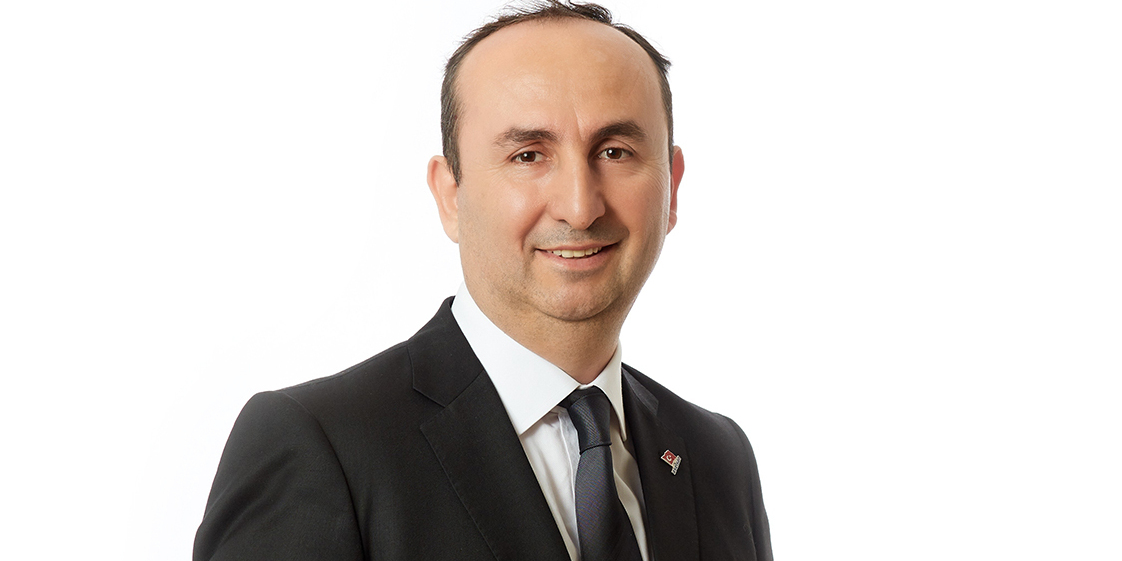
Mehmet Arik
Categories: Transportation, Energy & the Environment, Health Sciences, Engineering, Economic Development
Army invests another $4.35M in Auburn additive manufacturing qualification research
The U.S. Army is again asking Auburn University's National Center for Additive Manufacturing Excellence (NCAME) to help keep its caissons rolling toward the cutting edge.
In March 2022, NCAME initiated a $4.3 million Army project focused on the materials, parts and process qualification necessary for furthering implementation of additive manufacturing (AM) in Army operations, specifically those conducted by the Army’s Combat Capabilities Development Command Ground Vehicle Systems Center (DEVCOM GVSC). Few use-case scenarios for next-generation AM adoption illustrate the necessity of NCAME's qualification efforts better.
"The research being conducted here at Auburn is important to the Army because additive manufacturing is going to provide two different capabilities," Maj. Gen. Darren L. Werner, Special Assistant to the Commanding General for the United States Army Materiel Command, said during the Army Additive Manufacturing Summit hosted by the Samuel Ginn College of Engineering in 2021. "It's going to give us capability in our organic industrial base to integrate advanced manufacturing techniques, and it's also going to provide deployability of advanced manufacturing that we can potentially move into a forward location to produce and repair parts for our combat systems."
The Army's latest investment, a $4.35 million grant awarded this summer, will go toward establishing equivalency across multiple laser powder bed fusion (LPBF) printers — no easy task.
"Ensuring output consistency in a single AM machine is challenging enough," said NCAME director and project principal investigator Nima Shamsaei, Philpott-WestPoint Stevens Distinguished Professor of mechanical engineering. "Ensuring consistency and transferability of process output among different machines is something else. Though they may be utilized to produce the same part, different machines have different lasers, different powder delivery systems and different cooling characteristics, which may affect the part's performance."
For the Army's purposes, the equivalency challenges are even greater, Shamsaei said.
"Yes, the push towards integrating AM into the repair and maintenance of Army ground vehicles depends on consistency, repeatability, transferability and quality of manufactured parts, same as it does in other industries," he said. "But the scenarios we are talking about involve not just different machines but different depots across the globe. The idea is to be able to fabricate the same quality part regardless of location and regardless of the machine utilized."
Partnering on the project is the ASTM International Additive Manufacturing Center of Excellence (AM CoE), which will offer advisory services encompassing an assessment of the industry's current state of qualification and equivalency. The collaboration aims to produce an in-depth landscape analysis culminating in a strategic roadmap derived from the project's findings.
Co-principal investigator Shuai Shao, associate professor of mechanical engineering, believes that NCAME's approach to addressing the sorts of material variations in question, which Shamsaei has dubbed "AM's Achilles’ heel," is unique in the AM research arena.
"While one may focus only on aesthetic representation of mechanical properties, we try to establish equivalency at the structure level," Shao said. "We look for microstructure, porosity and surface texture and how these factors affect the mechanical properties. Eventually, the established equivalency will be validated using mechanical testing. Conventional approaches operate as if locking down the process will keep the structure in question the same. However, we have seen that the structure can be very sensitive to various factors including powder specification, process parameters, geometry, location on the build plate, to name a few."
In addition to significant experimentation, Shao said the project will incorporate simulation and data analytics, or machine learning.
"We're very focused on microstructural characterization because we believe equivalency should be established at that level and then validated through mechanical testing," Shamsaei said. "This approach to qualification will avoid fabrication and testing of hundreds of test specimens for each new machine and material combination. Our objective with this project is to continue developing a rapid and reliable approach for material and process qualification across different OEMs of metal LPBF equipment."
Media Contact: Jeremy Henderson, jdh0123@auburn.edu, 334-844-3591
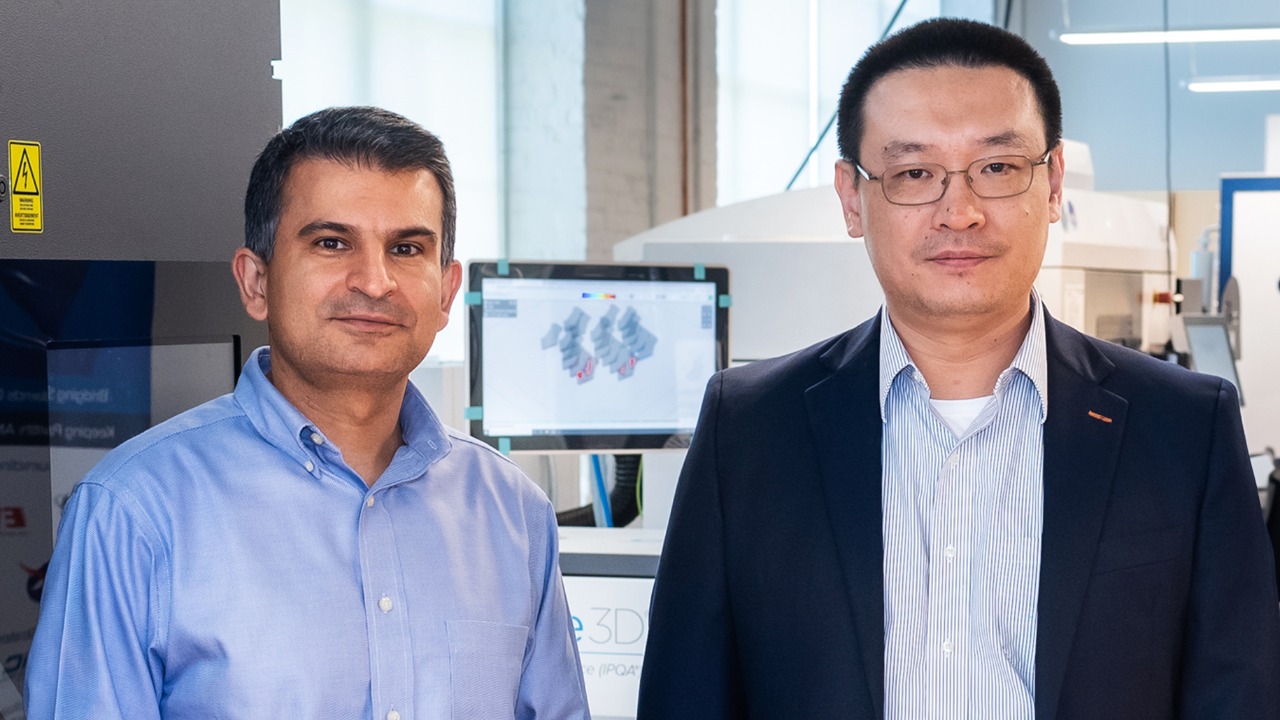
Nima Shamsaei and Shuai Shao
Categories: Transportation, Security, Engineering, External Engagement, Manufacturing
Industrial and systems engineering assistant professor earns NSF CAREER Award for AM fatigue life prediction through deep learning
Four years ago, GE Aerospace transitioned to using additive manufacturing (AM) for their new Catalyst turboprop engine. Which meant that 800 traditionally manufactured components were consolidated into just 12 metal AM parts, the development cycle was dropped from 5-10 years to only two, the engine weight reduced by 5% and the fuel consumption improved by 1%. For G.E., that's a pretty big deal. If other U.S. aircraft manufacturers went the same route, that would be a pretty big deal for the planet.
There's a reason AM research across the globe is expected to push $24 billion by 2027, and the revolutionary impact on the aviation industry is one of them. Experts estimate that substantial adoption of 3D-printed parts could knock 200 million gallons off of annual aviation fuel consumption.
If the parts work.
Despite the demonstrated success of metal additive manufacturing in various industries, the performance uncertainty of AM parts undermines the potential of deploying AM for high-consequence applications. Air travel. Space travel. Those sorts of thing.
Which is why the National Science Foundation (NSF) is turning to assistant industrial and systems engineering professor Peter Liu in the form of a $500,000 CAREER Award meant to generate new insight into defect formation relevant to fatigue performance of parts manufactured through laser powder-bed fusion (LPBF) and uncover the synergistic impacts of multi-scale factors on fatigue fractures.
Liu hopes the five-year project, Deep Learning to Understand Fatigue Performance and Processing Relationship of Complex Parts by Additive Manufacturing for High-consequence Applications, "will establish a physics-centric, machine learning framework for fatigue life predictions, serving as a technological foundation for future metal AM production of dynamic load-bearing applications and establishment of a resilient and reconfigurable supply chain, and thus, enhance the competitiveness of U.S. industry.”
"The biggest challenges in fatigue performance assessment for LPBF parts come from the nonhomogeneous microstructural traits from process dynamics, coupled with their complex geometry and imposed multiaxial loading," he said. "Current fatigue performance assessment methods and tests are unable to take all these contributing factors into account."
Liu believes the best way to address those challenges is to combine fracture mechanics, finite element (FE) methods and novel data-driven models.
"The goal of this early career effort is to understand fatigue failures of complex LPBF parts under multiaxial loading for data-driven fatigue life predictions," he said. "The research will investigate the nature of fatigue failures from plastic deformation and crack initiation at the highest stress concentrations and translate fatigue life predictions into evaluating the crack growth at the vulnerable zones using a multiscale approach. Then we will develop new statistical models and a novel multiscale multifactorial deep learning model to incorporate crack growth and stress distribution to understand their impacts on fatigue performance and predict fatigue life."
Liu is also the principal investigator on another recent NSF project aimed at applying deep learning to AM development.
"My research passion is synergizing machine learning and fundamental process physics to advance manufacturing knowledge, efficiency, and capability of LPBF," Liu said. "I am extremely grateful to the support from my department, the college, the National Center for Additive Manufacturing Excellence (NCAME), the Interdisciplinary Center for Advanced Manufacturing Systems (ICAMS) and the AI@AU Initiative. This CAREER project aligns with one of the strategic areas of research in advanced manufacturing and materials at the Samuel Ginn College of Engineering. It will contribute to the leading research and education capabilities in advanced manufacturing at Auburn, accelerate AI applications in manufacturing, and increase interdisciplinary collaboration at Auburn."
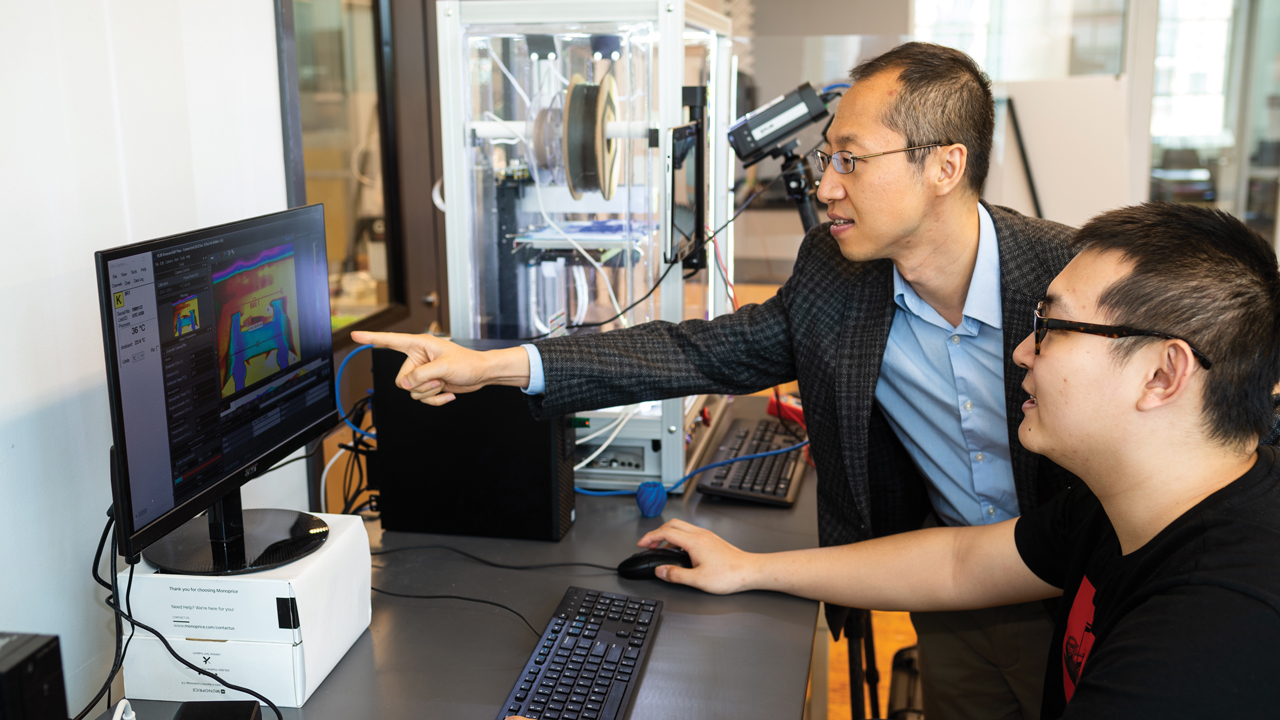
Peter Liu, left, recently received an NSF CAREER award to support his research into deep learning's application in predicting fatigue performance in additive manufacturing.
Categories: Transportation, Engineering, Manufacturing, Advanced Systems
Auburn University signs memorandum of understanding with KITECH to expand research efforts
Auburn University President Christopher B. Roberts signed a memorandum of understanding, or MOU, on Tuesday, Dec. 6, with Nak Kyu Lee, president of the Korea Institute of Technology, or KITECH, that will expand upon the collaborative research efforts of Auburn’s faculty and laboratories with local companies supported by KITECH.
Building on the signed MOU between the organizations in 2015, this newly expanded agreement includes the establishment of research and/or automotive technology support offices and laboratories, the creation of joint research projects and the exchange of technical information, periodic training symposia and consulting.
“As a land-grant university, Auburn aspires to deliver real-world, practical solutions,” Roberts said while addressing administrators and dignitaries at the ceremonial event held at The Hotel at Auburn University and Dixon Conference Center. “Through joint research efforts and projects, we can anticipate and meet the distinct needs of the automotive manufacturers and suppliers along the I-85 corridor that have strongly impacted our region’s economic climate. This partnership demonstrates an interchange of education, research and service, with global implications.”
The agreement spelled out a number of desired outcomes:
-
Establishment of research and/or automotive technology support offices and laboratories
-
Exchange of scientific/technical research materials, publications, information and advice
-
Development of mutually agreed-upon collaborative research projects
-
Identification of technical barriers encountered and improvement needed by manufacturers
-
Provision of technical solutions using means and technologies available at both institutions
-
Creation of joint research projects to identify funding opportunities through governmental agencies; and
-
Organization of periodic symposia on manufacturing technologies and related subjects
As identified by Roberts, the I-85 corridor remains a hotbed for automobile suppliers. KIA’s 2,200-acre plant in nearby West Point, Georgia, produces more than 300,000 automobiles per year. Hyundai’s 3.4 billion-square-foot plant just south of Montgomery, Alabama, is capable of producing nearly 400,000 vehicles per year.
“The Auburn-Opelika metropolitan area is an optimal region for joint research between academia and industry in the automobile field,” said Lee, whose institution is an application-oriented research institute founded with the mission to support the industry sector, especially the innovation of small- to mid-sized enterprises. “We plan to embark on joint research with Auburn University on innovative manufacturing technology. We also plan to answer to the demands of parts manufacturers in the region by utilizing the infrastructure and other means available at both institutions.”
Auburn University Outreach will manage the current initiative and coordinate the details of the memorandum of understanding. Since 2015, the Office of Professional and Continuing Education, a unit of University Outreach, and the Samuel Ginn College of Engineering have worked closely with KITECH on projects, including the “Korea US Automotive Technology Workshop” and various technology support and research projects.
“It is a great pleasure to not only continue this collaborative endeavor, but to expand upon it for the betterment of our stakeholders, community members and economic outlook,” said Royrickers Cook, Auburn University vice president for University Outreach and associate provost. The relationship between Auburn University and KITECH is longstanding, and we in University Outreach and the Office of Professional and Continuing Education are proud to be a part of this impactful collaboration.
“As we embark upon emerging electronic vehicle technologies, the expanded partnership positions each of us at the forefront of innovation, technological research and the promotion of economic development in the state of Alabama and beyond. KITECH’s values align well with Auburn’s land-grant mission of Outreach and help us carry out our responsibility to transform research into services that meet our communities’ most critical needs.”
Auburn University, recognized as a Carnegie R1 research institution, continues to cultivate the growing role that research and collaboration has played in improving business practices, finding new solutions to old problems and improving the quality of lives for thousands.
“In addition to advancing Auburn’s land-grant mission, this partnership demonstrates the value of strategic international and institutional engagements to the economic development of our state,” said Jim Weyhenmeyer, vice president for research and economic development. “Through this partnership with KITECH, we will continue strengthening Auburn’s capacity to lead automotive technology research and development, particularly in the global market.”
In the spirit of intellectual symposia following the signing ceremony, Auburn University and KITECH thought leaders combined to produce the first “KITECH-Auburn University Manufacturing Innovation Technology Forum.”
Larry Rilett, director of the Auburn University Transportation Research Institute within the Samuel Ginn College of Engineering, discussed “Opportunities and Challenges for Electric Vehicle Adoption: The Alabama Perspective.”
Mark Hoffman, assistant professor of mechanical engineering in the Samuel Ginn College of Engineering, discussed “Mobile Industry Status and Challenges.”
Flexing KITECH’s academic muscle, KITECH’s Sungwook Kang presented “Friction Stir Welding for EV Parts Manufacturing.”
Rilett, Hoffman and Kang were then joined by Dong Woo “Daniel” Yu, assistant director of Outreach Programs within the Office of Professional and Continuing Education for a 35-minute panel discussion.
Yu will coordinate details of the joint efforts between KITECH and Auburn University.
“Since the initial agreement was signed in 2015, I’ve been able to work with many Korean manufacturers to assess their technical problems, needs and provide training,” said Yu. “Having the opportunity to extend the resources from both Auburn University and KITECH has allowed us to assist several manufacturers. We’ll continue these joints efforts on a broader scope as we move forward, especially in the areas of emerging EV production technologies.”
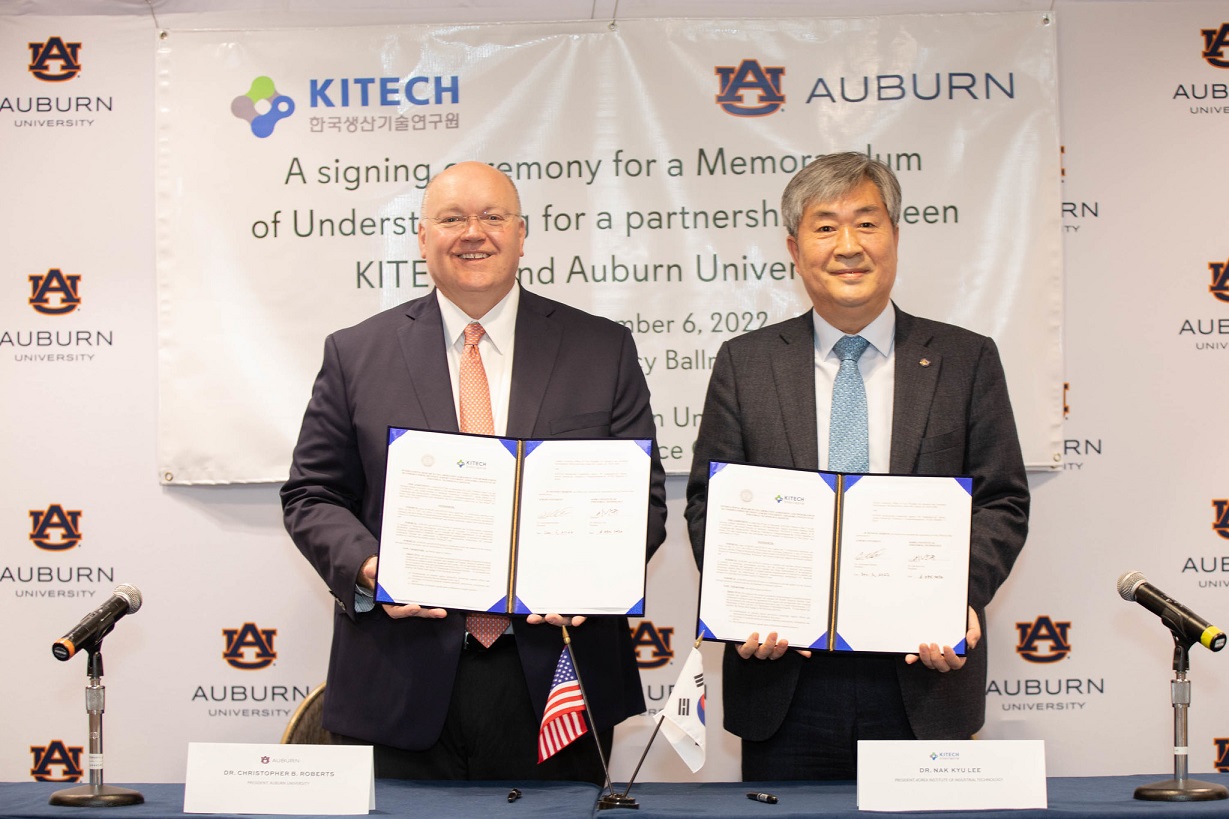
Auburn University President Christopher B. Roberts, left, signed a memorandum of understanding on Tuesday, Dec. 6, with Nak Kyu Lee, president of the Korea Institute of Technology, that will expand upon the collaborative research efforts of Auburn’s faculty and laboratories with local companies supported by KITECH.
Categories: Transportation, External Engagement, Manufacturing, Advanced Systems
Auburn statistician receives award from the Office of Naval Research to develop algorithms to help optimize naval navigation
Elvan Ceyhan, associate professor in the Department of Mathematics and Statistics, is the recipient of an award sponsored by the Department of the Navy, Office of Naval Research (ONR) under award number N00014-22-1-2572 for the project Adversarial Risk Analysis for Optimal Obstacle Evasion. The project, a collaboration with David Banks of Duke University, received an award of $358,000 with Auburn receiving $214,000 and Duke receiving $144,000.
The overall goal of the research project is to create procedures that avoid adversarial threats for continuous paths such as ships navigating the ocean. It will result in algorithms and methodology in Adversarial Risk Analysis (ARA).
“Imagine a grid over the ocean with traversable edges and diagonals,” said Ceyhan. “This network grid superimposed on the ocean’s surface helps us to unlock approximate paths for naval ships to safely navigate.”
“Adversarial Risk Analysis looks at a navigating agent and an adversarial agent, which would be capable of putting obstacles in the path,” said Ceyhan. “With this work, we can minimize the potential damage and expense on the path of the navigating agent to reach its required destination.”
The proposed approach is a combination of two concepts: Canadian traveler’s problem (CTP) in optimization and ARA. CTP was motivated by the traversal strategies in harsh winter conditions in Canada. “Think of a traveler who needs to reach a target, say, a pharmacy or a supermarket from her home in a vehicle,” Ceyhan explained. “However, some streets may be blocked (due to heavy snow), and she needs to navigate through the street which forms the traversal grid.”
The current project, which proposes a relatively new concept for finding feasible solutions to problems through both basic and applied research, is an adaptation of CTP to weighted and partially blocked spatial networks with adversarial agents on the network.
“We will first define the problem specification and complete the Adversarial Risk Analysis,” he said. “In the next phase of the project, we will use reinforcement learning to find the policy that is nearly optimal.”
In addition to life-saving research in naval navigation, this work also has real-world applications in both robotics and inventory allocation.
“Operations research is filled with finding solutions to traversal problems hindered with obstacles,” he added. “This work can help operations management find more successful solutions to overcome such challenges.”
Any opinions, findings, and conclusions or recommendations expressed in this material are those of the author(s) and do not necessarily reflect the views of the Office of Naval Research.
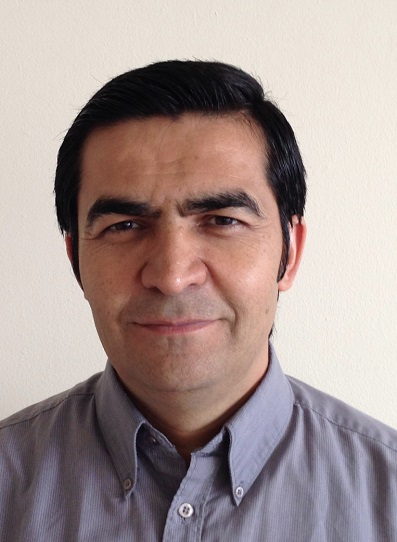
Elvan Ceyhan
Categories: Transportation, Security
Aerospace professor earns Office of Naval Research Young Investigator Award
Umberto Saetti believes modeling and simulating rotor downwash can develop safer helicopter landings at sea. The Office of Naval Research believes in Umberto Saetti.
Saetti, assistant professor in aerospace engineering, was recently granted a $510,000 Young Investigator Award from the Office of Naval Research (ONR YIP) for his upcoming study, “Linearized High-Fidelity Aeromechanics for Extended Reality Simulation and Control of Shipboard Interactions.”
Two Virtual Reality (VR) motion-base flight simulators, which will be used in the study, were recently installed within Auburn’s Extended Reality Flight Simulation and Control Lab.
The purpose of the project: find solutions that will preserve human life and prevent millions of dollars in aircraft from being destroyed. Take two recent U.S. Naval accidents, for example. In 2017 off the coast of Queensland, Australia, an MV-22B Osprey crashed into the ship-deck of the USS Green Bay, killing three and injuring many more. A near-miss occurred in 2015 when an Osprey landed short of the flight deck of an amphibious transport ship and hung off the rear of the boat. There were no injuries, this time.
The problem: heavy rotor downwash which, when interacting with the ship deck, hull or water surface, recirculate into the rotor, causing increased power demands and adverse handling effects.
“Modeling of the rotor downwash and its interactions with the sea surface, ship deck, and ship superstructures is key in understanding the adverse effect on the flight dynamics and performance of rotorcraft in shipboard operations,” Saetti said. “Moreover, the ability to replicate these interactions in real-time flight simulations could help supplement the creation of Launch and Recovery Envelopes (LREs) aboard naval vessels. This virtual approach to LRE certification could be used to replace potentially unsafe live simulations during a dynamic interface (DI) period.”
Saetti offered three components to the proposal: modeling, control of the downwash interactions, and pilot simulations in full-body haptic feedback suits (to occur in year three).
“If we are able to model and replicate these conditions in a simulator, we can gain more insight of what’s causing these effects,” he said. “And also, it would be in a safe environment.”
But how are these real-life characteristics replicated in a simulator?
“Suppose that you have your rotorcraft flying above the ship deck or sea surface. Then, to model the interaction of the rotor wake with the ship deck or the sea surface, you will need to introduce a phantom, or image, helicopter rotor below that surface as if the ship deck or water surface were a mirror. In general, the more surfaces you add that constitute obstacles you are trying to model, the more simulations get complex. In spite of this complexity, the proposal is not only modeling these interactions, but also try and find a way to simplify them.
“Once we know the interactions that occur, you will get basically use a procedure called linearization. We're making these complicated relationships between the rotorcraft and ship deck much easier, mathematically speaking, so that they're constituted by simple algebraic relationships.”
Saetti is no stranger to helicopter research for the U.S. military. His study, “State-Variable Implementation and Linearization of Simulations with Multi-Disciplinary Aeromechanics,” with the Vertical Lift Research Center of Excellence, earned a five-year, $571,000 contract last summer.
BY JOE McADORY
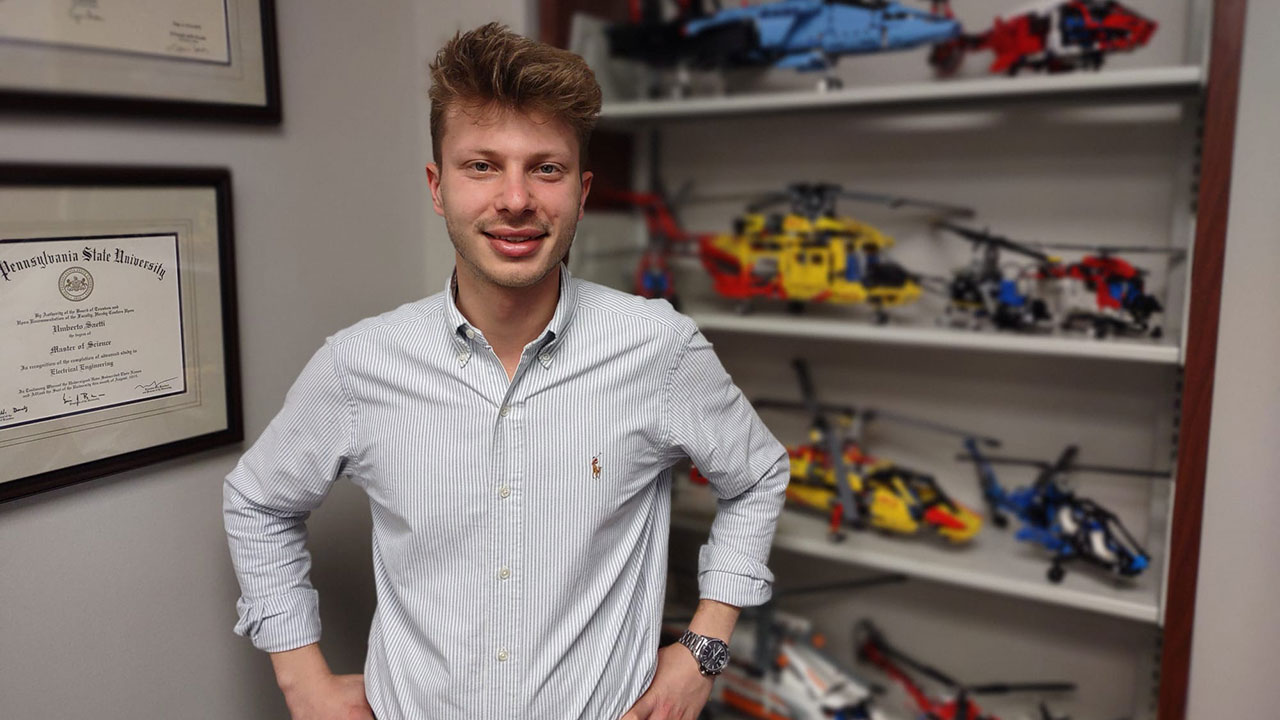
Umberto Saetti has a passion for helicopters and finding new ways to enhance safety.
Categories: Transportation, Engineering
Aerospace professors successfully partner with U.S. Air Force Agility Prime Program
Three aerospace engineering professors – Imon Chakraborty, Roy Hartfield, and Ehsan Taheri -- successfully concluded a $150,000 Phase I Small Business Technology Transfer (SBIR-STTR) project funded by the U.S. Air Force Agility Prime program.
Their project, “Electric Extended Range Airship with Modular Payload,” designed and implemented propulsion and flight control systems for a 40-foot-long airship, which serves as a test bed for larger, future applications such as near space applications.

Imon Chakraborty
In conjunction with Skyborne Technology, an emerging leader in the development and production of helium-filled airships, and the prime contractor, Research in Flight, an Auburn, Alabama company dedicated to developing new aerodynamic and hydrodynamic analysis tools for aerospace engineering applications, the test concluded with a successful flight demonstration of the subscale prototype on Sept. 29 in rural Wewahitchka, Fla.
“The idea was to make novel, or unconventional air vehicles that have to meet specific criteria,” said Chakraborty, an assistant professor at the college. “These vehicles should not require a runway, so you cannot develop an airplane. It should be something that takes off vertically. The ultimate intent is to have a full-scale version that can carry people with a very strong focus on electricity.”
Hartfield, the Walt and Virginia Woltosz Professor at the Samuel Ginn College of Engineering, said the ship’s modular payload represents the potential for multiple uses.

Roy Hartfield
“We could perform such tasks as launching UAVs from the airship, capturing the UAVs from the airship, and resupplying the charge to the UAVs. There are many other applications, but that’s the best technology we’re trying to demonstrate; future development with Skyborne Technology will also focus on teaching the edge of space,” stated Hartfield.
The Skyborne Airship Technology is highly versatile with many derivative applications, but airborne UAV support augmented by detachable tethers is the cutting-edge technology that we are developing through this AFWERX program.”
Research in Flight CEO Vivek Ahuja added, “Immediately applicable derivative applications for airships of this class including monitoring for border control, or carrying payload with high-resolution cameras for other surveillance opportunities.”

Ehsan Taheri
The prototype will serve as a benchmark for testing and data collection in preparation for a proposed full-scale vehicle with expansive logistics and support applications. Insights gained from the tests will allow computer-simulated scenario modeling to assess the tether-airship platform for future applications.
Though Skyborne Technology fabricated the airship, Chakraborty and Taheri, assistant professors at the college, developed and manufactured the propulsion and control systems and flew the airship during the test flight.
“The airship uses four propulsive units,” said Chakraborty, a licensed pilot. “They gimbal and can move in two axes, pitch and yaw – there’s one at each corner of the ship. You also have someone controlling the airship from the ground. You can’t expect them to control all of the propulsive units individually. That’s demanding way too much. You can only have a small number of controls that a human being can be expected to manipulate. Those controls must then translate into gimbal angles for each of these four and revolutions per minute for each of the propellers.
“Ehsan and I simulated this on a computer as a test, then Ehsan has a super-smart graduate student, Yevhenii “Jack” Kovryzhenko, who is excellent with hardware and methods to interface software programs with hardware that we used for the project.”
The project transcends the successful airship test in Florida. It also showcases Auburn aerospace’s strength as a research leader in higher education.
Of 1,615 project proposals sent to the Air Force Agility Prime Program, only 274 were funded. Six of Auburn’s project proposals from Taheri, Chakraborty and Hartfield were funded.
“This shows that the faculty at the college’s Department of Aerospace Engineering has a lot of innovative ideas and is very active,” said Taheri. “We can complete the tasks from simulation to experiment for all of the components needed for these types of projects.”
Hartfield added, “We took a polished approach and put a lot of effort into verifying what we put in the proposal, having a well-thought-out plan with technical goals that matched the programming goals.”
Media Contact: Joe McAdory, jem0040@auburn.edu, 334.844.3447
BY JOE McADORY
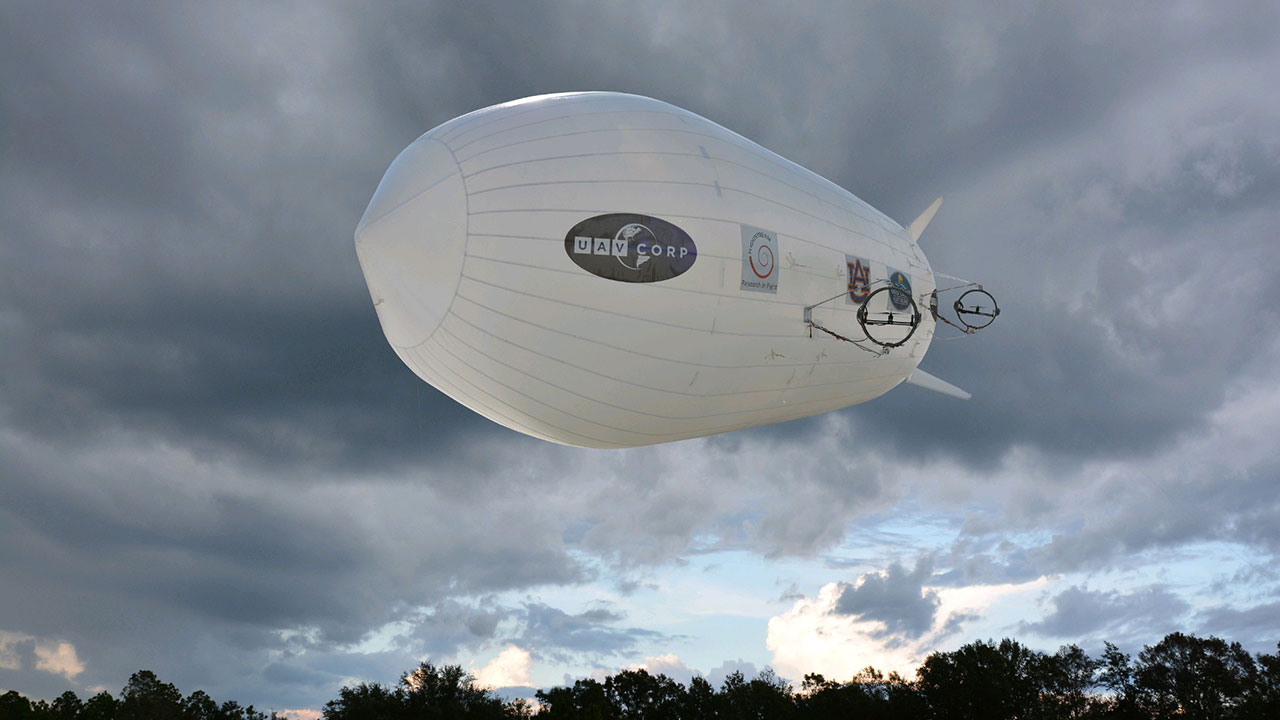
The airship's modular payload provides an opportunity for multiple uses.
Categories: Transportation, Engineering
Auburn faculty members to research lead-free defense electronics as part of $7M award
Auburn University will soon help strengthen the economic and force posture of the United States’ lead-free defense electronics industrial base through participation in the newly-launched Defense Electronics Consortium (DEC).
The DEC was established by the U.S. Partnership for Assured Electronics through an award from the U.S. Department of Defense. The total award amount is expected to exceed $42 million – $7 million of which is expected to come to Auburn – and will be distributed during a period of five to seven years.
The first year of the project was funded at $3.9 million, with $830,000 awarded to Auburn Engineering. Auburn faculty will partner with researchers from Purdue University and the University of Maryland to focus on the Lead-Free Defense Electronics Project, the first initiative to flow through the DEC.
When compared to consumer electronics, defense electronics are subjected to harsher environments and are often designed for a much longer lifespan. Auburn faculty, led by principal investigator Sa’d Hamasha, assistant professor of industrial and systems engineering, will develop a comprehensive evaluation system for solder selection to meet specific defense-related requirements.
“The outcome of this research is a lead-free Solder Users Handbook to ensure a safe transition of aerospace and defense electronics to lead-free technology,” he said. “The lead-free project includes a plan for developing a comprehensive solder agnostic evaluation system for defense lead-free technology. The goal is to enable future new solders and electronics packaging technologies and processes for specific defense use cases.”
The interdisciplinary project is a collaboration between faculty in Auburn’s industrial and systems engineering and mechanical engineering departments. From the Department of Industrial and Systems Engineering, Hamasha will direct the research program, department chair John L. Evans is a co-principal investigator and will manage the USPAE consortium interface, and assistant professors Daniel Silva and Peter Liu are also co-principal investigators. Participating faculty from the Department of Mechanical Engineering include department chair and Quina Professor Jeffrey Suhling and professor George Flowers, Graduate School dean, as co-principal investigators. Emeritus professors Wayne Johnson from the Department of Electrical and Computer Engineering and Michael Bozack from the Department of Physics will also contribute.
“Auburn’s involvement comes after 25 years of excellence in electronics packaging, manufacturing and reliability and one of the largest research efforts in lead-free solder in the United States,” said Evans, the Charles D. Miller Chair Professor.
Hamasha explained that in addition to the Auburn team’s wealth of research experience, Auburn’s state-of-the-art facilities will be used to fill the gaps in thermal cycling, drop shock and vibration testing, all important factors to determining military suitability.
“Our team has experience investigating mechanical properties, failure and fatigue behavior and reliability of more than 50 standard and enhanced lead-free solder alloys, as well as the manufacturability of these materials,” Suhling said. “And our research has targeted mission critical electronic products for military, automotive, aerospace and industrial applications that are exposed to harsh environments.”
Overall, the work produced by the DEC has the potential to make a great impact in the defense industry.
“The DEC work will accelerate the use of advanced electronics technology for the defense industry, while also improving product quality, reliability, performance and reducing product costs,” Evans said.
Media Contact: Cassie Montgomery, cmontgomery@auburn.edu, 334.844.3668
BY CASSIE MONTGOMERY
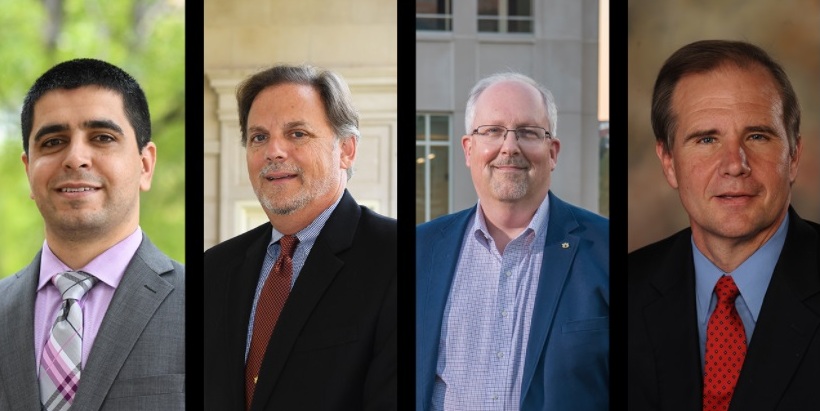 From left, Sa'd Hamasha, John L. Evans, Jeffrey Suhling and George Flowers
From left, Sa'd Hamasha, John L. Evans, Jeffrey Suhling and George Flowers
Categories: Transportation, Engineering, Manufacturing
Auburn debuts sophisticated new autonomous vehicle research facility
Auburn University recently opened the doors to a sophisticated new autonomous vehicle research facility at Auburn’s National Center for Asphalt Technology test track — one of the few facilities of its kind in the nation attached to a test track.
The addition will aid researchers in Auburn University’s GPS and Vehicle Dynamics Laboratory, whose work is frequently conducted outdoors.
The facility provides a garage with multiple bays and lifts for commercial trucks and passenger vehicles, office space for researchers, a conference room and an observation area overlooking NCAT’s 1.7-mile oval test track.
“The fact that we have our own test track where we can run autonomous vehicles and autonomous testing attached to this facility I think is an unbelievably unique asset,” said David Bevly, the Bill and Lana McNair Distinguished Professor of mechanical engineering and co-director of the GAVLAB along with assistant research professor Scott Martin.
Since Bevly joined the Auburn Engineering faculty in 2001, the GAVLAB has built a strong reputation in autonomous vehicle navigation and developed a broad sponsored research portfolio, with projects ranging from the Department of Defense and the Federal Highway Administration to many private industry partners.
With various sponsors visiting each month, the facility’s planned observation area gives the GAVLAB team a high-quality space to demonstrate its research. Bevly’s group has also conducted demonstrations for legislators and the Alabama Department of Transportation.
“It’s a great facility for us as a team, but also allows us to showcase our work,” Bevly said.
With a growing research thrust in transportation engineering, the autonomous research facility also demonstrates Auburn’s commitment to supporting these research initiatives.
“Auburn is a major player in transportation engineering research in the nation,” said Steve Taylor, associate dean for research. “The GAVLAB and our other transportation engineering researchers have brought in nearly $50 million in sponsored research awards over the past three years. This new facility is an exciting development for Auburn and there will be much more to come.”
BY CHRIS ANTHONY
Media Contact: Jeremy Henderson, jdh0123@auburn.edu, 334-844-3591
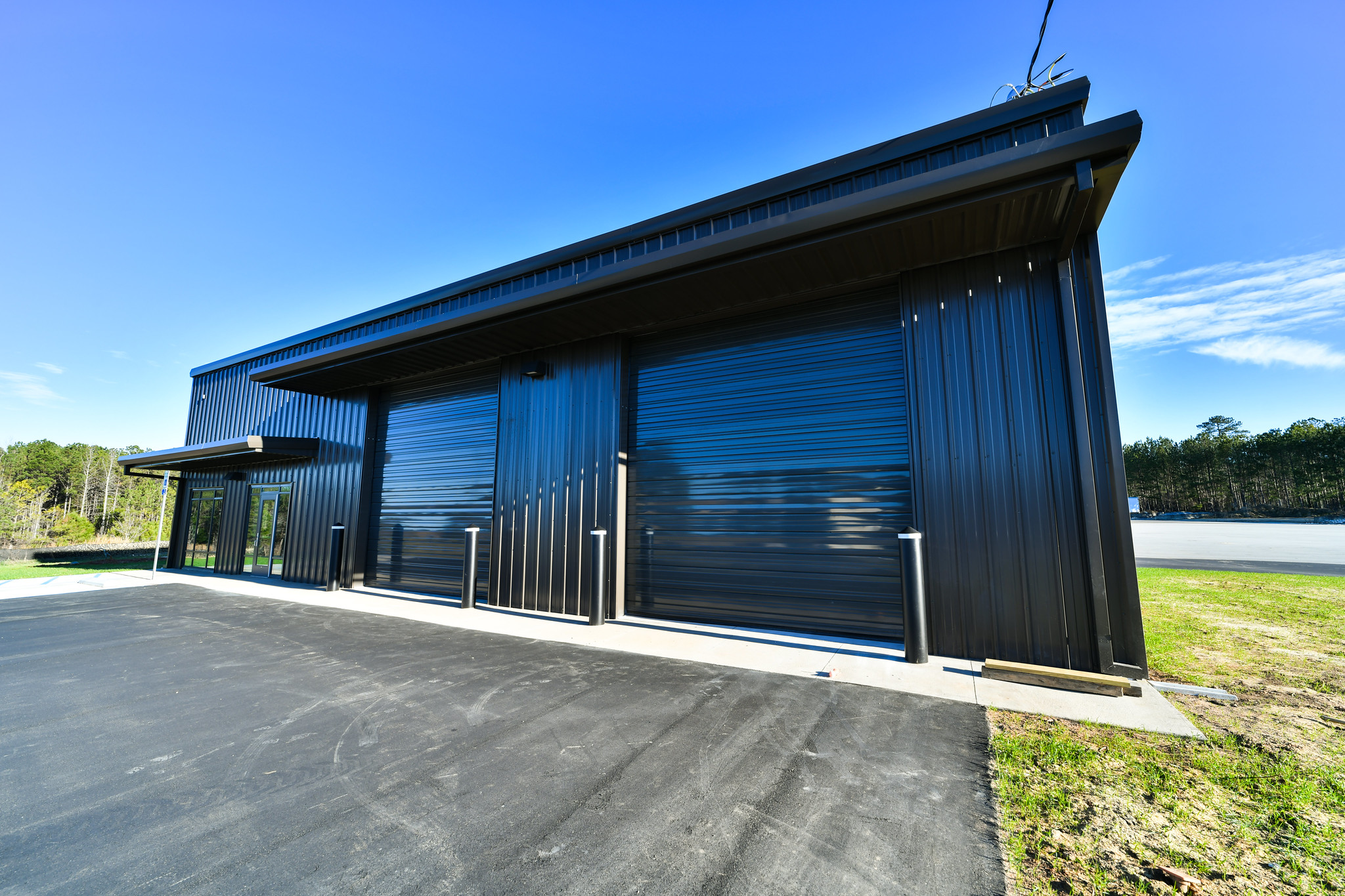
Auburn University's new autonomous vehicle research facility
Categories: Transportation, Engineering, Advanced Systems
FAA invests $3 million in Auburn University additive manufacturing research
Thanks to a recent $3 million grant from the Federal Aviation Administration (FAA), the National Center for Additive Manufacturing Excellence (NCAME) at Auburn University will soon initiate a two-year project focused on improving commercial air travel through the use of 3D-printed (or additively manufactured) metal components.
The project involves fabricating metal parts from multiple industrial-scale metal 3D printers. It aims to specifically address issues related to understanding the variability in performance of the same parts made on different machines, as well as issues related to understanding how microscopic features in the 3D-printed metal affect overall fatigue and fracture properties. Both are key areas in the development of additive manufacturing (AM) specifications that the FAA wants to eventually apply in commercial airlines.
“This is what I call the ‘Achilles heel’ of additive manufacturing,” said NCAME director Nima Shamsaei, Philpott-WestPoint Stevens Distinguished Associate Professor of mechanical engineering. “Such variations make the qualification and certification of AM materials and parts challenging.”
The FAA said the partnership is ultimately intended to improve safety by standardizing certification of existing and emerging structural applications of advanced materials, a research area in which NCAME quickly emerged as an international leader, especially in the area of materials used for spaceflight.
Established in 2017 through a public-private partnership between Auburn and NASA, NCAME is also one of the founding partners of the ASTM International Additive Manufacturing Center of Excellence, which aims to close AM standards and workforce gaps.
“By understanding the sources of variability, controlling them, or accounting for them, we can generate more reliable materials data, and more reliable AM products,” said Shamsaei, who serves as co-principle investigator (PI) on the project.
Co-PI Steve Taylor, associate dean for research, agrees.
“By teaming our faculty, who are global leaders in research on additively manufactured metal components, with the top engineers and scientists at FAA, we are confident that we can develop new knowledge that will help engineers design safer, more efficient aircraft,” Taylor said. “Auburn University is honored to be collaborating with the FAA."
Other investigators on the project include Shuai Shao, associate professor of mechanical engineering; Hareesh Tippur, McWane Professor of mechanical engineering; Nick Tsolas, assistant professor of mechanical engineering; Jeff Suhling, chair of the Department of Mechanical Engineering; Masoud Mahjouri-Samani, assistant professor of electrical and computer engineering; Alex Vinel, assistant professor of industrial and systems engineering; Daniel Silva, assistant professor of industrial and systems engineering; and Jia (Peter) Liu, assistant professor of industrial and systems engineering. Mike Ogles, director of NASA Programs, serves as project manager.
BY JEREMY HENDERSON
Media Contact: Jeremy Henderson, jdh0123@auburn.edu, 334-844-3591
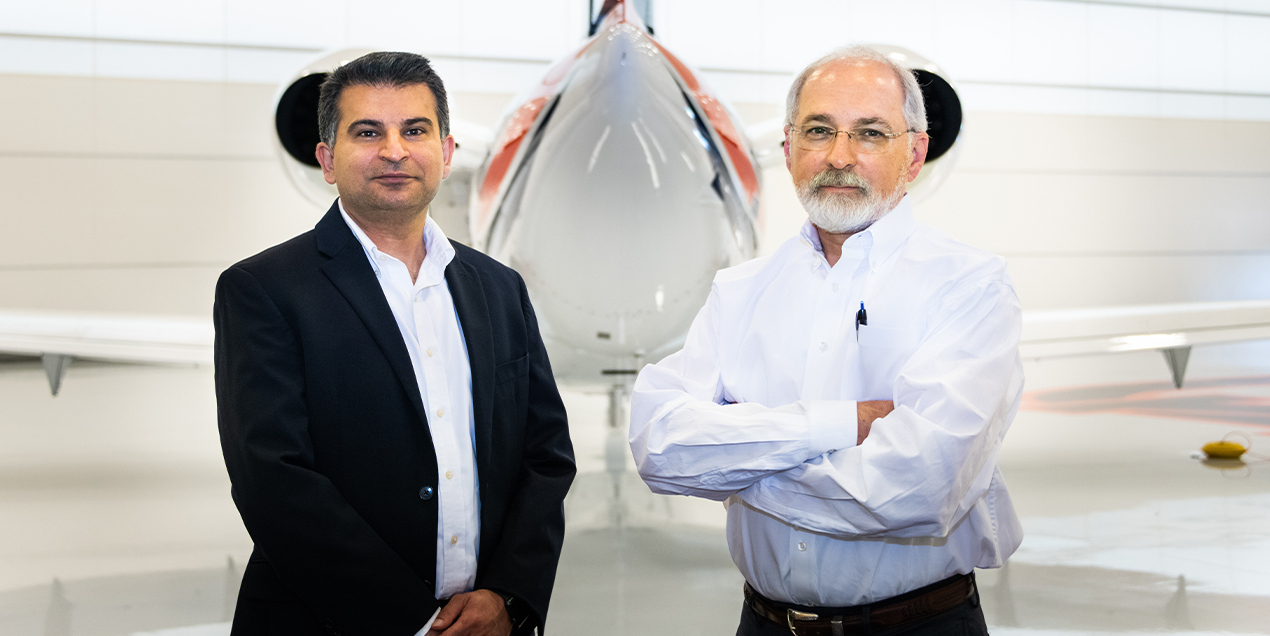 Nima Shamsaei and Steve Taylor
Nima Shamsaei and Steve Taylor
Categories: Transportation, Engineering
Auburn University building new autonomous vehicle research facility
For researchers in Auburn University’s GPS and Vehicle Dynamics Laboratory, prepping autonomous vehicles outside in Alabama’s elements—from the sweltering summer sun to pop-up thunderstorms—has become a near daily occurrence.
Whether researchers are debugging algorithms, installing sensors or running data analyses, much of the work from the GPS and Vehicle Dynamics Laboratory, or GAVLAB, is done outdoors—and easily impacted by changes in the weather.
That is about to change with the planned addition of a sophisticated new autonomous vehicle research facility at Auburn’s National Center for Asphalt Technology test track. The facility is expected to provide a garage with multiple bays and lifts for commercial trucks and passenger vehicles, office space for researchers, a conference room and an observation area overlooking NCAT’s 1.7-mile oval test track.
The building, estimated to cost approximately $800,000, will be one of the few autonomous research facilities in the nation attached to a test track.
“The fact that we’ll have our own test track where we can run autonomous vehicles and autonomous testing attached to this facility I think will be an unbelievably unique asset,” said David Bevly, the Bill and Lana McNair Distinguished Professor of mechanical engineering and co-director of the GAVLAB, along with assistant research professor Scott Martin.
Since Bevly joined the Auburn engineering faculty in 2001, the GAVLAB has built a strong reputation in autonomous vehicle navigation and developed a broad sponsored research portfolio, with projects ranging from the Department of Defense and the Federal Highway Administration to many private industry partners.
With various sponsors visiting each month, the facility’s planned observation area will give the GAVLAB team a high-quality space to demonstrate its research. Bevly’s group has also conducted demonstrations for legislators and the Alabama Department of Transportation.
“I think it will be a great facility for us as a team, but also to showcase our work,” Bevly said.
With a growing research thrust in transportation engineering, the autonomous research facility also demonstrates Auburn’s commitment to supporting these research initiatives.
“Dave and his GAVLAB team are one of our top research groups on campus, and their work has elevated Auburn to an internationally prominent position in navigation and vehicle dynamics for autonomous vehicles,” said Jeff Suhling, the Quina Professor and department chair for mechanical engineering. “Our department is proud to commit resources, along with the Samuel Ginn College of Engineering, to support high-impact researchers. We think this facility will really help set us apart from other universities in autonomous vehicle research.”
BY CHRIS ANTHONY
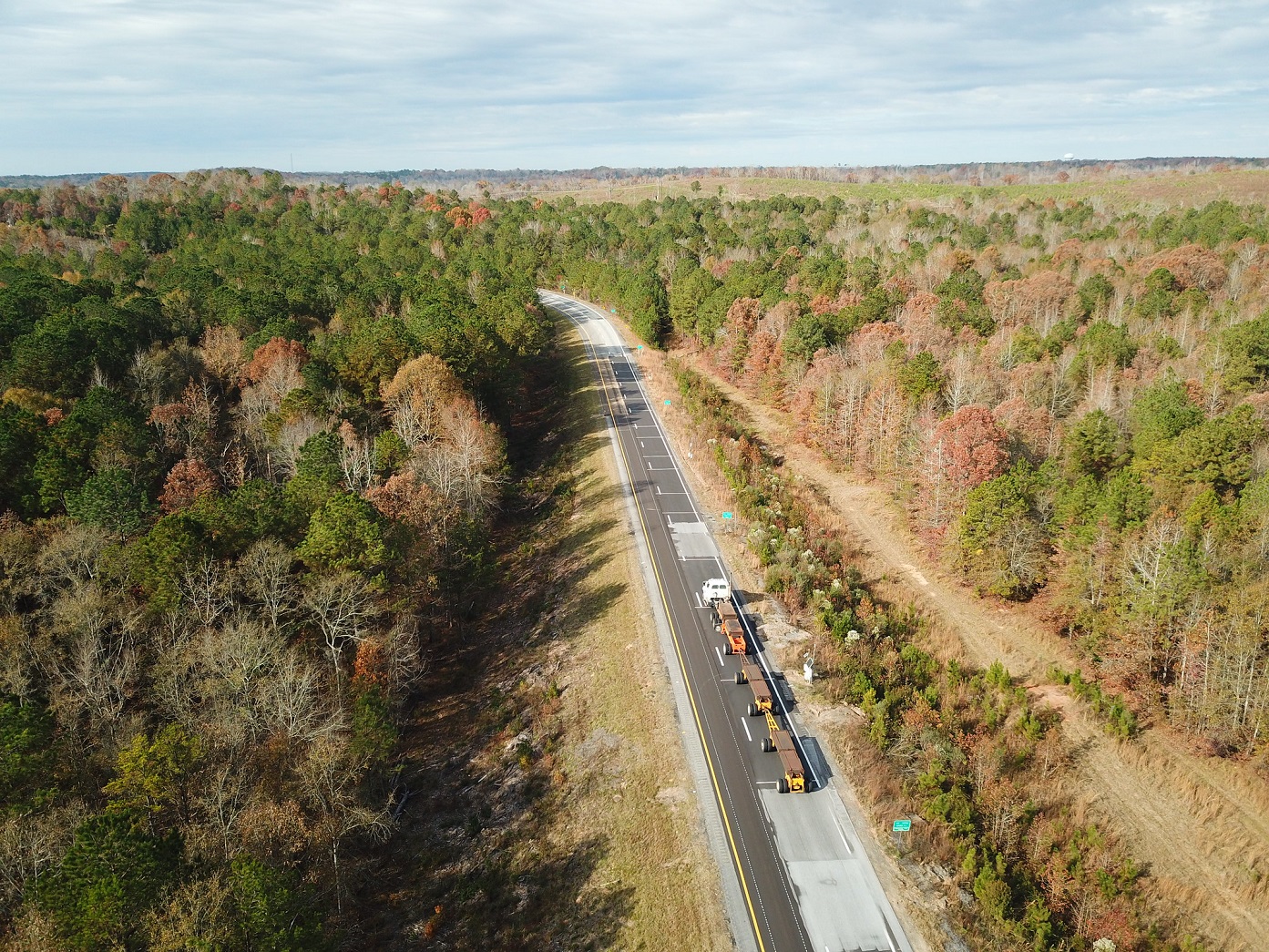
The Auburn University Samuel Ginn College of Engineering is building a new autonomous vehicle research facility at Auburn’s National Center for Asphalt Technology test track, making it one of the few such facilities in the nation attached to a test track.
Categories: Transportation, Engineering
Auburn’s National Center for Asphalt Technology works to improve nation’s roadways
Auburn University is transforming roads across the country.
For over three decades, Auburn’s National Center for Asphalt Technology, or NCAT, has focused on evaluating and developing new technologies that make the nation’s roads smoother, quieter, safer, longer lasting and more economical.
Home to a track where engineers and students develop and test innovative road-surfacing methods, NCAT’s research centerpiece is a high-speed, full-scale accelerated asphalt pavement testing facility. Located 30 minutes from Auburn’s campus, the 1.7-mile oval is comprised of experimental test sections sponsored cooperatively by highway agencies and private industry. In this real-world laboratory, drivers of a heavy five-truck fleet apply more than a decade of typical interstate traffic in just two years, providing fast and implementable research to meet the demands of maintaining America’s highway infrastructure.
“We can conduct high-risk experiments here while avoiding any danger to the traveling public on open roads,” explains Jason Nelson, test track manager. “We’re developing tests and specifications that can be used to design more sustainable pavements with high amounts of recycled materials. States can use these tests as part of their design procedures to help determine how a road will perform in regard to rutting resistance, resistance to cracking and long-term durability.
“This will ultimately lead to better roads for drivers across the country.”
Agencies across the country are also using NCAT’s research findings to preserve their roadway networks and maximize their budgets. A major study focusing on pavement preservation, the concept of applying the right treatment to the right road at the right time, is underway to quantify the life-extending and condition-improving benefits of various treatments that can be used from county roads to major highways. Through a partnership with the Minnesota Department of Transportation, these results will be applicable to roads in both northern and southern U.S. climates.
NCAT’s achievements don’t end at its practical research. Each year, its engineers transfer the latest advancements to professionals worldwide through training, workshops, videos, presentations, publications and outreach activities. Since 1988, its professor training course has provided over 500 college professors clear and up-to-date resources to use in teaching asphalt materials, pavement design and construction courses to undergraduate civil engineering students.
“One of our greatest accomplishments has been inspiring the next generation of leaders in asphalt pavement technologies,” said Randy West, NCAT director. “Although we’ve built a reputation from the quality of our research, our success is truly measured in people. Students at Auburn are able to gain real-world experience by working in our co-op program and taking courses led by our outstanding faculty, and our former graduate students are rapidly becoming industry leaders throughout the world.”
NCAT attracts more than $6 million in research funding annually and remains committed to its mission of providing innovative, relevant and implementable research, technology development and education that advances safe and economically sustainable asphalt pavements—from Auburn to the entire nation.
BY CHRISTINE HALL
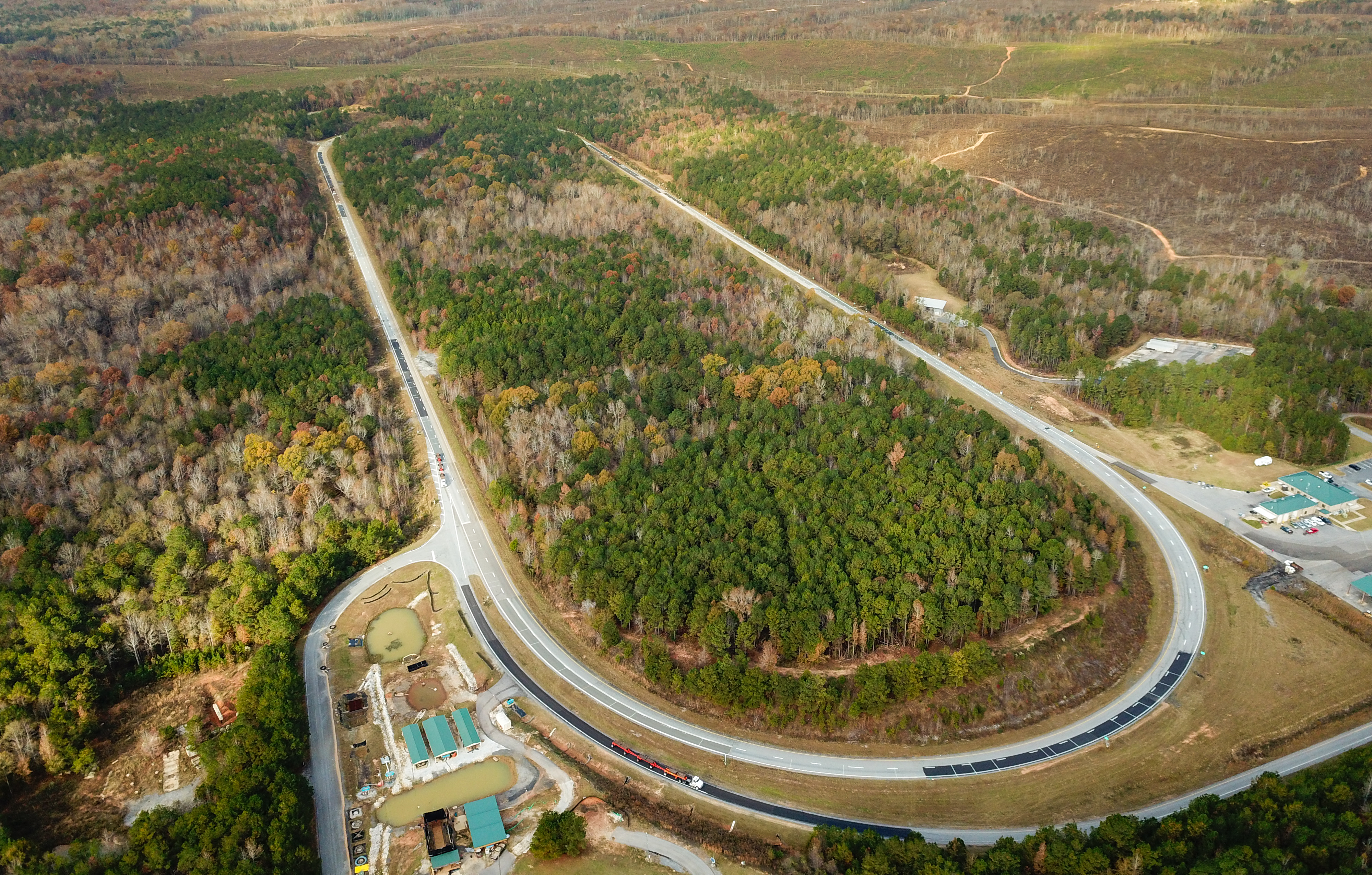
The National Center for Asphalt Technology is how Auburn University is transforming roads across the country. The 1.7 mile oval track is comprised of experimental test sections sponsored cooperatively by highway agencies and private industry. Drivers of a heavy five-truck fleet apply more than a decade of typical interstate traffic in just two years, providing fast and implementable research to meet the demands of maintaining America’s highway infrastructure.
Categories: Transportation
Nearly 600 Auburn students showcasing their research and creativity April 9 at Auburn Research Student Symposium
Nearly 600 Auburn University students with a flair for research and creativity will showcase their talents when they gather for the annual Auburn Research Student Symposium.
With projects ranging from chemical engineering to plant pathology to architecture and design, the symposium on April 9 will provide Auburn and Auburn Montgomery students an opportunity to share their discoveries university-wide. The daylong event will take place in the Student Center.
Undergraduate and graduate students from almost every department have registered to participate through posters, oral presentations and creative scholarship displays. Approximately 400 of the young researchers will present posters and displays more than 180 will give 10-minute talks, all under the watchful eyes of judges who will award top honors in a variety of university-wide and college-specific categories.
An awards ceremony and reception will be held April 18 at 5 p.m. in the Student Center ballroom. The keynote speaker will be Michael Zabala, assistant professor of mechanical engineering, who earned his bachelor’s degree at Auburn in 2007.
Steve Taylor, chair of the Research Symposia Committee and associate dean for research in the Samuel Ginn College of Engineering, said, “Our students’ innovative research covers many areas, from projects in STEM disciplines [science, technology, engineering and mathematics] to the arts and humanities. They are working with our world-class faculty on life-changing projects that could shape new developments in many fields.”
Following the April 9 symposium, Nobel Laureate in Chemistry George P. Smith will visit Auburn University and the College of Veterinary Medicine April 10-11. Professor Smith will present a public lecture at 2 p.m. April 10 in The Hotel at Auburn University and Dixon Conference Center auditorium, which will be followed by a reception. On April 11, he will be available to meet with faculty and students at the College of Veterinary Medicine.
A fall event, the Auburn Research Faculty Symposium, will be held in September to recognize faculty excellence in research and creative scholarship.
More information about the student symposium is available at www.aub.ie/researchstudentsymposium or by contacting Taylor at taylost@auburn.edu.
WRITTEN BY CHARLES MARTIN
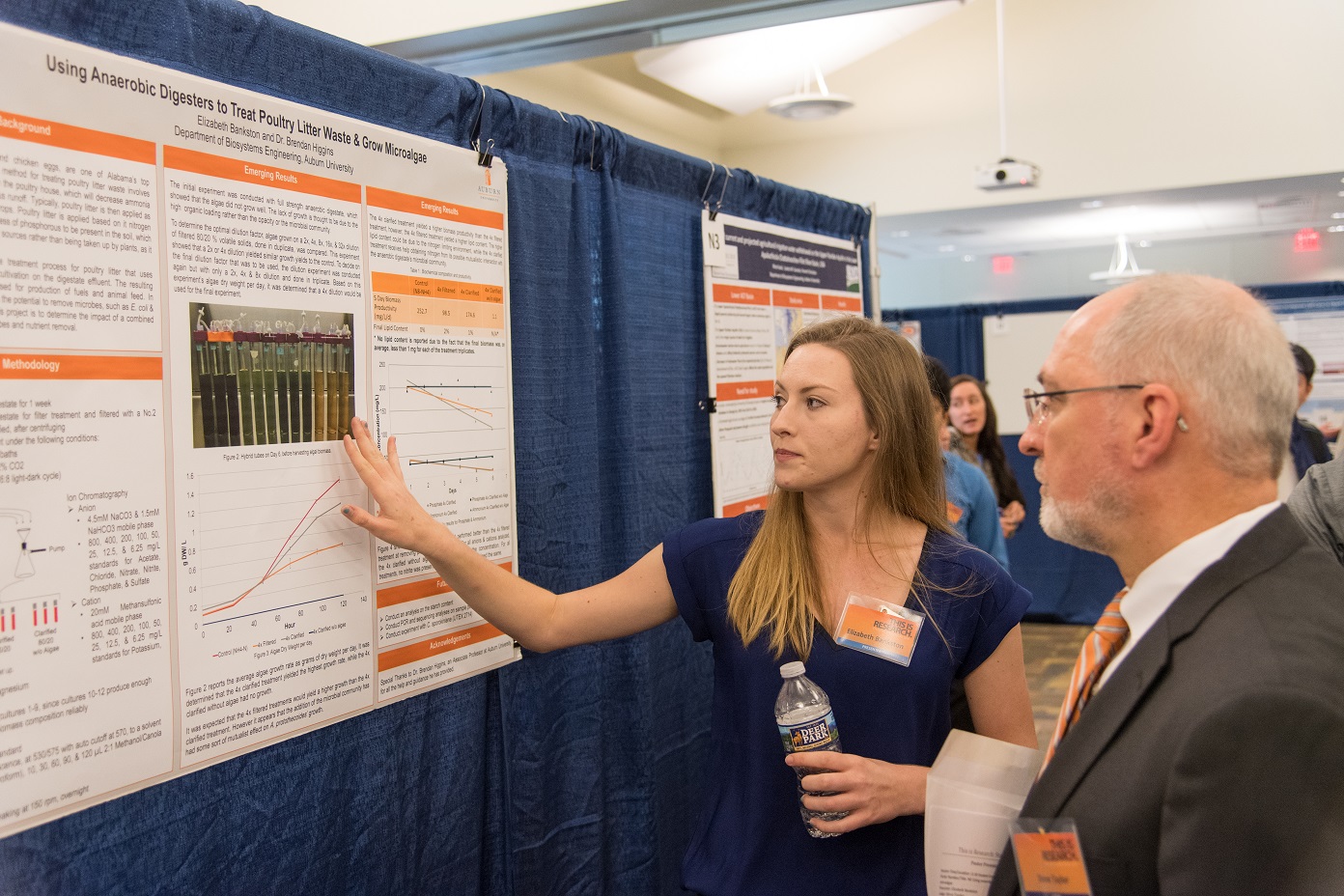
Auburn students with a flair for research and creativity will showcase their talents when they gather April 9 in the Student Center for the annual Auburn Research Student Symposium. Pictured, student Elizabeth Bankston discusses her research poster with Steve Taylor, chair of the Research Symposia Committee, at last year’s symposium.
Categories: Transportation, Cyber, Energy & the Environment, Health Sciences, Food Systems, Security, Engineering, Creative Scholarship
Auburn University achieves research milestone with ‘R1’ Carnegie classification
In another affirmation of its drive forward to excellence, Auburn University achieved a research milestone Monday - being elevated to an “R1” institution by the Carnegie Classification of Institutions of Higher Education.
The announcement follows a concerted effort by Auburn to elevate its commitment to life-saving research, beginning with an announcement by Auburn President Steven Leath in December 2017 and subsequent awarding of $5 million for three years toward the Presidential Awards for Interdisciplinary Research, or PAIR. An R1 designation by Carnegie is reserved for doctoral universities with the highest levels of research activity.
Among 120 institutions to receive the R1 designation Monday, Auburn was listed in the top 100 of such universities, raising its classification from an already lofty “high research” R2 classification to Monday's “very high research activity” R1 label.
“This tremendous designation acknowledges the hard work involved in the pioneering discoveries happening at Auburn every day,” said Leath, who was recently named one of seven new members appointed by President Trump to the National Science Board, a policy-making body of the National Science Foundation. “We are grateful to the university’s faculty and staff, especially Graduate School Dean George Flowers, for their unwavering commitment to elevating Auburn’s profile as a world-class academic institution.
“Auburn is on the move, and this prestigious distinction recognizes Auburn’s critical role in creating new knowledge and helping others live better lives.”
Universities considered for the R1 designation must have awarded at least 20 research/scholarship doctoral degrees and had at least $5 million in total research expenditures, according to Carnegie’s classification website. Auburn has grown its research efforts in both STEM and non-STEM areas, furthering its institutional commitment to offer solutions to real-world problems and grow its reputation as a go-to university in providing results that transform and inspire.
“Auburn University is known for its innovative and transformational research, and receiving the R1 classification is a significant accomplishment,” said Jennifer Kerpelman, interim vice president for research. “This classification recognizes the dedication, commitment and hard work of Auburn’s faculty and student researchers across all disciplines.”
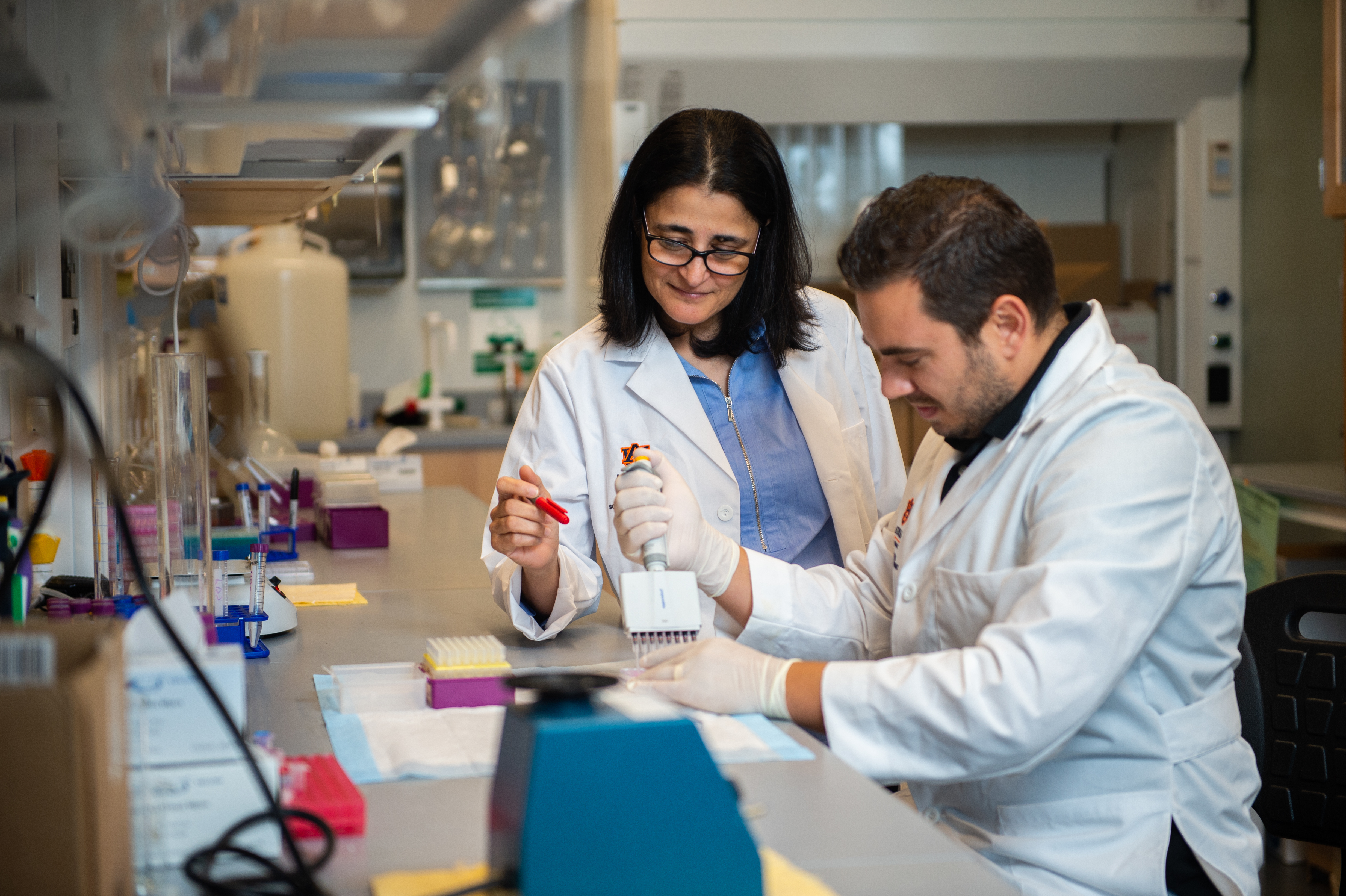
Dr. Amal Kaddoumi, left, a professor in Auburn’s Department of Drug Discovery and Development, works in a lab with graduate research assistant Sweilem Al Rihani. Kaddoumi is leading a multi-disciplinary team in an investigation of oleocanthal, a molecule that appears naturally in extra-virgin olive oil, as a novel preventative treatment for such diseases as Alzheimer’s or dementia.
Categories: Transportation, Cyber, Energy & the Environment, Health Sciences, Science, Technology, Engineering and Mathematics (STEM), Food Systems, Engineering, Auburn In the News, Creative Scholarship
Auburn, partner organizations sign agreements for additive research centers
Auburn University, ASTM International and other partner organizations on Monday celebrated the launch of two new centers of excellence in additive manufacturing aimed at accelerating research and development, standardization and innovation in that field, also known as 3-D printing.
Global standards developer ASTM International launched its Additive Manufacturing Center of Excellence with Auburn University, NASA, manufacturing technology innovator EWI and the UK-based Manufacturing Technology Centre. Auburn and NASA also formally launched the National Center for Additive Manufacturing Excellence.
ASTM International President Katharine Morgan said, “The synergy among EWI, MTC, Auburn and NASA will help fill the gaps in technical standards that this industry needs to drive innovation. As a result, we’ll empower industries that are eager to apply additive manufacturing to aerospace, auto, medical and more.”
AMCOE’s advisory board comprised of U.S. and international public and private sector leaders met for the first time today while other meetings involved research and development as well as education and workforce development teams. The events come on the heels of AMCOE’s international launch on July 13 at the MTC, where European industry and government officials gathered to celebrate this initiative.
Auburn University President Steven Leath said, “Auburn is committed to growing research, solving real-world problems and establishing partnerships that support these transformative initiatives, such as our thriving additive manufacturing program. By investing in skilled researchers and first-rate facilities, we aim to drive additive technology forward and unleash its full potential. We look forward to continuing to work with our industry and government collaborators.”
Auburn University is in the final stage of renovations to the Gavin Engineering Research Laboratory, which will in part house additive manufacturing research funded through the centers.
Auburn was selected for the two research partnerships in March.
Media Contact: Chris Anthony, chris.anthony@auburn.edu, 334.844.3447

Components made through additive manufacturing are shown in the additive manufacturing lab in Wiggins Hall at Auburn University.
Categories: Transportation, Health Sciences, Engineering, External Engagement
Timm paves a new way in Hong Kong with keynote address
David Timm, Brasfield & Gorrie professor in Auburn University’s Department of Civil Engineering, served as a keynote speaker at the 2nd International Conference on Sustainable Urbanization in Hong Kong.
Timm’s keynote address, “Pavement Design: Past, Present and a Sustainable Future,” provided a comprehensive view of pavement design in the U.S. and featured perpetual pavement research findings from the National Center for Asphalt Technology Pavement Test Track in Opelika, Ala.
In his presentation, Timm stressed the importance of pavements in healthy infrastructure. The growing demand for higher-performing, longer-lasting pavements has led pavement engineers to embrace mechanistic-empirical approaches. Timm’s presentation evaluated these approaches which more readily accommodate innovation in construction, materials and better prediction of pavement performance over time.
The international conference, hosted by the Hong Kong Polytechnic University, included 300 presentations representing 30 countries. The conference aimed to provide an international forum for the scientific and engineering community to examine the challenges arising from the massive urbanization programs underway throughout the world and to find effective solutions to ensure stable urbanization globally.
Contributed by Valerie Cashin

Categories: Transportation
Auburn University receives nation's first FAA authorization to operate Unmanned Aircraft Systems Flight School
"This is an honor for Auburn University," said Bill Hutto, director of the Auburn University Aviation Center. "We will conduct commercial flight training for operators of unmanned aircraft systems outdoors and untethered. We will have the ability to offer training courses at different locations here and around the state for Auburn students, faculty, members of other public agencies and the general public."
Unmanned aircraft systems, or drones, are expected to be a key component of the state's and nation's economy as opportunities continue to arise in business and industry, as well as in research areas such as engineering, building science and agriculture.
"It's a major win for the state," Alabama Lt. Gov. Kay Ivey said. "We're building off Alabama's already rich history and robust industry in aerospace and aviation and now leading the nation in an area of emerging technology that's critical to our success in future economic opportunities."
The FAA approval requires that operators of unmanned aircraft pass a written exam and a flying test, both of which Auburn will administer. "It ensures that the operators have a good understanding of how to safely and properly operate an unmanned aircraft system," Hutto said.
Auburn University has been involved in aviation education for more than 80 years and has been providing fight training for pilots for nearly 75 years. Auburn offers three aviation/aerospace degrees: aviation management, professional flight management and aerospace engineering.
"I commend Auburn University on obtaining the new FAA approval," said Seth Hammett, a member of the Auburn University Aviation Center Steering Committee. "It is another step in continuing the long-time educational excellence in aviation and aerospace at the university. Our state will benefit by having unmanned aircraft system operators trained in the safe, effective use of these aircraft."
Related link: http://ocm.auburn.edu/aviation_center/
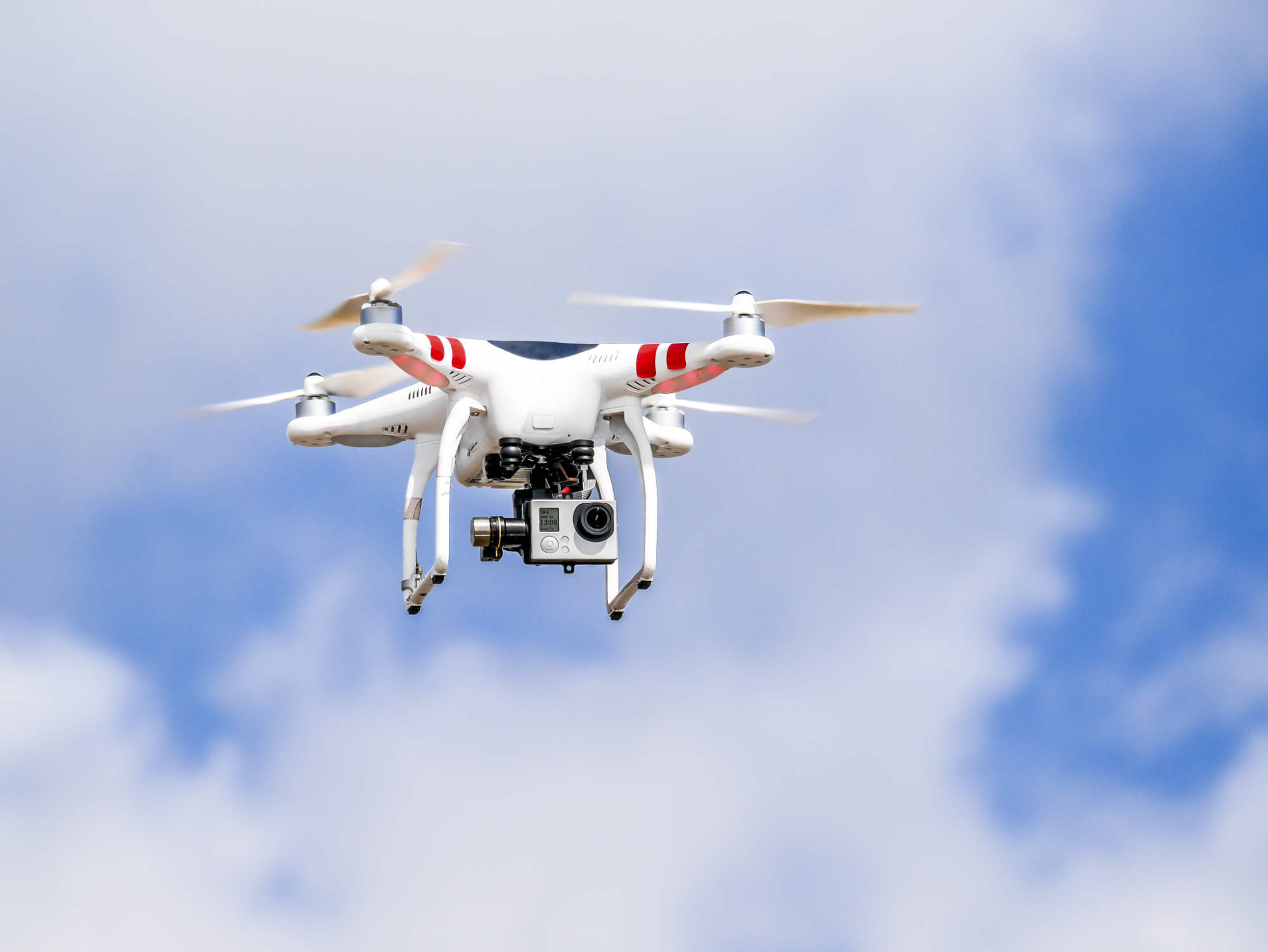
Categories: Transportation
Auburn University hosting forum: Additive Manufacturing – The Next Industrial Revolution
On July 30, 2015, Auburn University will be hosting a by invitation only forum on industrialized additive manufacturing.
Experts will discuss the application of this advanced technology for industries ranging from aerospace to biotechnology. Industry leaders from GE Aviation, GKN, NASA, Carpenter Technology, Alabama Laser, U.S. Army Aviation and faculty from Auburn University, University of Alabama, UAH and University of Memphis will describe the role their organizations are playing in developing, implementing and utilizing new processes and computer-aided hardware and software to produce components from material and composites once considered exotic.
A keynote address will be given by Greg Morris, the General Manager of Additive Technologies for GE Aviation.
To learn more about this day-long forum and networking reception to follow, or if you are interested in attending, please email forum organizers at auees@auburn.edu.

Categories: Transportation, Cyber, Energy & the Environment, Health Sciences, Science, Technology, Engineering and Mathematics (STEM), Food Systems, Engineering
2016 Auburn University Research Advisory Board Advancement of Research & Scholarship Achievement Award presented to Tatarchuk
At its fall meeting in October, Auburn University’s Research Advisory Board presented Dr. Bruce Tatarchuk, a professor in Auburn’s Department of Chemical Engineering, with the 2016 Research Advisory Board Advancement of Research and Scholarship Achievement Award. The award recognizes Tatarchuk’s innovative research accomplishments spanning a 34-year career at Auburn.
Composed of more than 40 industry professionals from across the country who actively support Auburn’s research efforts, the board established the award in 2014 to recognize significant research and scholarly activity that exemplifies and advances Auburn’s research and scholarship mission. The recipient of the annual award receives a $25,000 grant to further his or her research.
Tatarchuk, director of Auburn’s Center for Microfibrous Materials Manufacturing, was recognized for his impactful work with novel structures of matter that employ micron-diameter fibers to increase thermal and electrical conduction in kinetic processes. He holds 12 U.S. patents, as well as dozens of foreign patents, and his innovations include materials that are used in virtually all commercial aircraft operating in U.S. airspace, battery electrodes for low earth orbit satellites, electrode structures used in hybrid vehicle capacitors, and gas-to-liquid-fuel conversion processes.
“I am pleased that the Research Advisory Board has honored Dr. Tatarchuk with this prestigious award,” said John Mason, Auburn’s vice president for research and economic development. “He has shown throughout his career that the commercialization of high-quality scientific research can benefit society in major ways. This is a well-deserved honor for Dr. Tatarchuk,” Mason added.
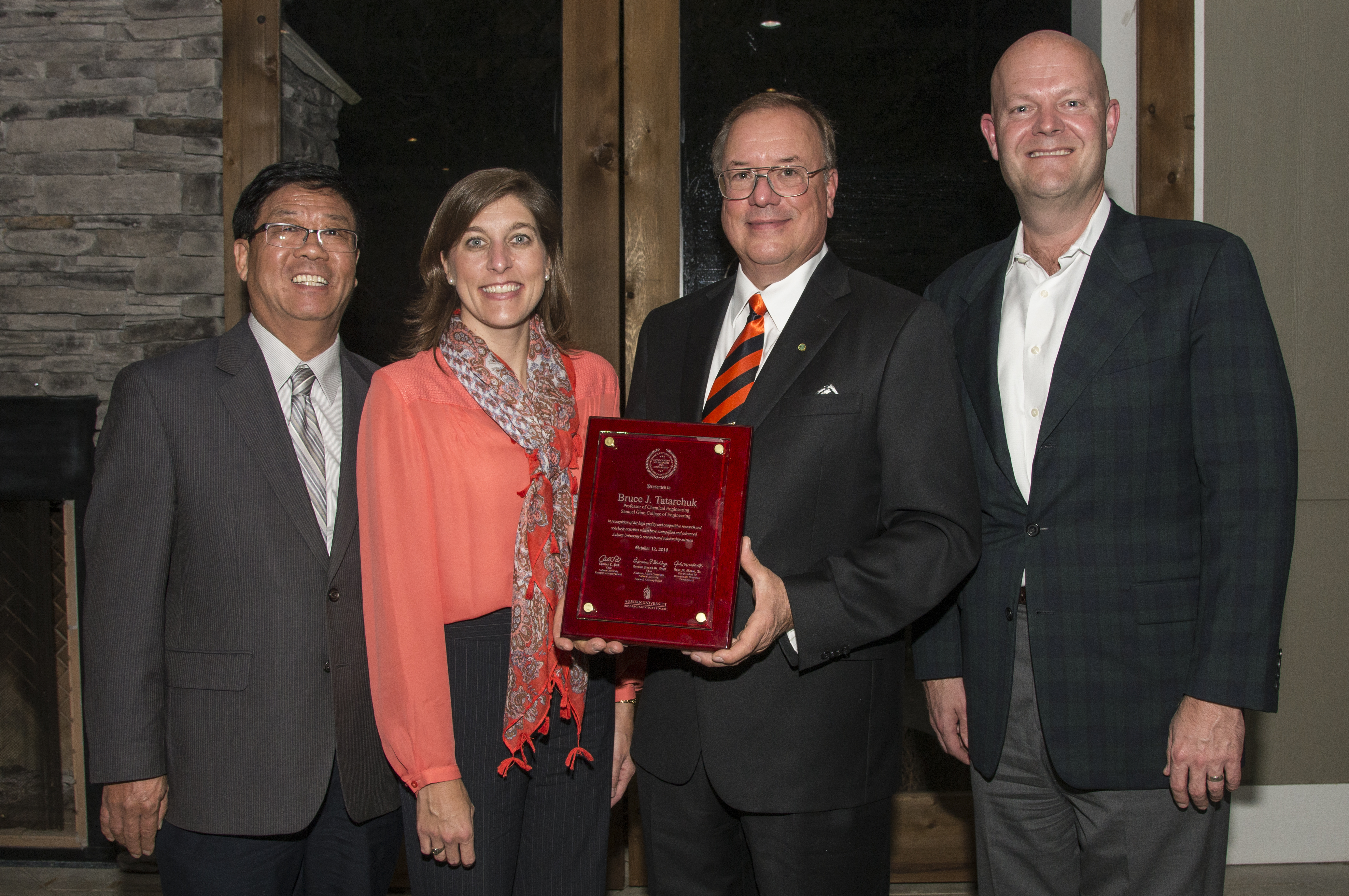
Categories: Transportation, Energy & the Environment, Science, Technology, Engineering and Mathematics (STEM)
Auburn University’s Warrior Research Center collaborating with U.S. Army Game Studio to develop aviation-training technology for FAA
Auburn University is collaborating with the U.S. Army and the Federal Aviation Administration to develop innovative aviation learning and training modules using virtual, interactive and multimedia technology. The partnership seeks to develop gaming modules that can be implemented into the FAA's current curriculum for air traffic controllers.
A cooperative research and development agreement signed on Tuesday, June 6, enables Auburn's Warrior Research Center to join forces with the U.S. Army Game Studio, which is part of the U.S. Army Aviation and Missile Research, Development and Engineering Center, or AMRDEC, at Redstone Arsenal in Huntsville. The project is through the FAA's Air Transportation Center of Excellence for Technical Training and Human Performance, of which Auburn serves as a core team member.
The team will develop air traffic controller training technology using research and science-based knowledge on training adult learners and the use of gaming to improve learning and retention. The modules will demonstrate team capabilities to provide realistic, engaging and effective training.
AMRDEC's Army Game Studio has established unmatched capabilities in the development of virtual, interactive and multimedia technology used for outreach, recruiting, education and training. The studio brings together artists, soldiers and gaming experts to create virtual environments for soldiers to train in without putting them at risk in combat. Rapid prototyping of gaming technology tools ensures that the computer-generated training environments are user-friendly and customizable to the soldiers. The studio is best known for developing the free online U.S. Army video game, "America's Army."
"The Army Game Studio is my go-to place for any training, animation, augmented learning or virtual environment that I need," said JoEllen Sefton, director of the Warrior Research Center and associate professor in Auburn's School of Kinesiology. "I know that the talented team there can take anything we develop, or anything I can imagine, and make it real."
A cross-disciplinary effort, the Warrior Research Center is led by Auburn's School of Kinesiology in the College of Education and includes research from engineering, industrial design, psychology, business, veterinary medicine and human sciences. Collaborators also include Auburn's ROTC program, MRI Research Center, Center for Disability Research and Policy Studies and the Gastrointestinal Research Center, as well as the Edward Via College of Osteopathic Medicine on Auburn's campus.
Warrior Research Center investigations include the effects of military vehicles on a body's skeletal system, blood flow and muscles; consequences from prolonged helicopter sitting; evaluation of neck injuries from prolonged wear of helmets; reducing injury and improving warfighter performance. Studies also explore the design of a universal cockpit, controllers and pilot seats to improve mission efficacy and decrease pilot fatigue and injury.
by MORGAN S. MARTIN

Jeff Langhout, left, acting technical director of the U.S. Army’s Aviation and Missile Research, Development and Engineering Center, signs a cooperative research and development agreement with John Mason, Auburn’s vice president for research and economic development. The organizations will develop innovative aviation learning and training modules using virtual, interactive and multimedia technology.
Categories: Transportation, Engineering
Auburn University enhancing commerce and research through unmanned aircraft systems
Unmanned aircraft systems, or drones, are more than a passing hobby—Auburn University officials believe they could be a key component in the nation's commerce and research.
U.S. Rep. Mike Rogers recently received a firsthand look at the potential when Auburn University Aviation Center officials demonstrated rotary-wing and fixed-wing unmanned aircraft, showing how they can be used in business and industry, as well as in research areas such as engineering, building science and agriculture.
"Auburn leads the nation in UAS technology, and I'm excited by the opportunities it will create for both Alabama and the nation," Rogers said.
Earlier this year Auburn received the nation's first FAA approval to operate a new Unmanned Aircraft Systems Flight School as part of its Aviation Center. The FAA approval requires that operators of unmanned aircraft pass a written exam and a flying test, both of which Auburn will administer through its flight school.
"The potential is immense," said Bill Hutto, Aviation Center director. "Unmanned aircraft systems can safely and efficiently inspect bridges and construction projects, conduct search-and-rescue operations and play a key role in precision agriculture."
In agriculture, unmanned aircraft systems equipped with sensors, such as infrared cameras, can quickly and easily monitor the health of crops and work in conjunction with GPS-guided ground equipment that can deliver resources—water, pesticides and fertilizer—precisely where they are needed.
"Precision agriculture techniques can save time and money and increase yields and profits for agribusiness," said Steve Taylor, head of Auburn's Department of Biosystems Engineering. "These tools will have a major impact in many areas, not only for agricultural crops but also for better management of our forests."
Auburn will conduct UAS flight training on campus and around the state for Auburn students and faculty, members of public agencies and the general public. Hands-on training covers basic flight maneuvers through obstacle courses, while classroom work covers the proper uses for unmanned aircraft, FAA rules and regulations and how to pursue FAA approval to fly commercially. The first class is tentatively set to begin later this month at Auburn.
The university has been involved in aviation education for more than 80 years and has been providing fight training for pilots for nearly 75 years. Auburn offers three aviation/aerospace degrees: aviation management, professional flight management and aerospace engineering.
More information is available on the Auburn University Aviation Center website at http://www.auburn.edu/aviationcenter.
Published: 08/11/2015
By: Charles Martin
Video by: Kevin Fichtner https://youtu.be/L9waP6bZ2a4
Categories: Transportation, Engineering, External Engagement
Auburn University agreement opens door with Korean automotive industry
Auburn University President Jay Gogue has signed a memorandum of understanding with Youngsoo Lee, president of KITECH, to formalize the joint research efforts of Auburn's faculty and labs with local companies supported by KITECH.
The Korea Institute of Technology, or KITECH, recently documented collaboration in research and technology development with Auburn University to support the Korean automotive industry. Established in 1989, KITECH is a government funded research and development institute headquartered in Cheonan, South Korea, with several research centers in Korea, as well as international cooperation centers in China, Vietnam, Indonesia, Germany and Santa Clara, California.
"This signing creates a portal for Auburn University that facilitates our collaboration with the local automotive industry, the parent companies in Korea and the Korean government," said Andy Gillespie, Auburn University assistant provost for international programs. "Our King Sejong Institute, in partnership with Keimyung University, is our cultural bridge to Alabama's Korean and American communities, and our new relationship with KITECH will become our technical bridge, building on recent efforts by a number of Auburn's colleges and offices."
Other visitors present at the signing were Byung-Wook Choi, director of the KITECH USA Technology Cooperation Center; Sangkug Lee, director of the International Cooperation Department; Minjin Kim, researcher for the KITECH USA Technology Cooperation Center; and SangWoo Lee, administrator in the International Cooperation Department.
In 2014, the Office of University Outreach held a workshop for local companies supported by KITECH. With this declaration of a commitment to joint research, the Office of the Vice President for Research and Economic Development continue this collaboration with its involvement.
"There are over 60 Korean companies along the I85 Corridor between Montgomery and West Point, Georgia," said Larry Fillmer, executive director of the Department of External Engagement and Support. "This MOU provides a framework for collaboration among KITECH subject matter experts and Auburn faculty and researchers."
Throughout the last five years, Samuel Ginn College of Engineering professor Song-Yul 'Ben' Choe has been working with the Office of International Programs and KITECH to establish a regional office in Auburn for joint research and development efforts for the Korean automotive industry.
"Through supporting agreements, research projects, technical assistance, facilities and labs at Auburn may be shared to provide operational and manufacturing solutions to problems being encountered by Korean companies in our immediate region," said Fillmer. "In the future, KITECH may seek to establish an office and operations in the Auburn University Research Park."
Categories: Transportation, Engineering, Auburn In the News
Auburn University participates in Heavy Duty Truck Platooning Study
Auburn University was recently featured in an article for Heavy Duty Trucking Info for their work related to Truck Platooning:
A report on the first phase of research into the possible benefits of truck platooning technologies showed that all trucks in a platoon gained fuel efficiencies, with the lead truck gaining as much as a 5 percent improvement while the trailing truck got up to 10 percent improvement.
The study, which was conducted by Auburn University’s GPS and Vehicle Dynamics Laboratory, along with partners Peloton Technologies, Peterbilt Motors, Meritor-Wabco and the American Transportation Research Institute.
As part of the Federal Highway Administration’s advanced research project on heavy truck cooperative cruise control, the first phase of the study looked at the commercial feasibility of driver assistive truck platooning, or DATP.
DATP makes use of available vehicle-to-vehicle communications and other technologies such as adaptive cruise control, collision avoidance systems, radar, GPS data and other systems to allow two or more trucks to “platoon” in a very tight formation at highway speeds, thereby reducing drag and helping all trucks in the platoon gain mpg benefits. The trucks constantly maintain a communication link which allows them to share data. If the lead truck’s collision avoidance system activates its adaptive cruise control to slow down, the following truck or trucks will do the same.
To read the full article, visit: http://www.truckinginfo.com/news/story/2015/05/truck-platooning-report-shows-fuel-economy-gains.aspx
Categories: Transportation
Auburn University kicks off Baja SAE North American racing season
More than 1,300 college students representing nearly 100 teams from around the globe – as far as India, Mexico and Egypt – traveled to the National Center for Asphalt Technology (NCAT) Pavement Test Track facility in Opelika to compete in the Baja SAE Auburn North American racing competition on April 9-12. This engineering event is sanctioned by the Society of Automotive Engineers (SAE) and is considered Baja SAE’s most rugged of all its collegiate design competitions.
This was the fourth time for Auburn’s Samuel Ginn College of Engineering to host the four-day competition, which combined static and dynamic racing events, including an endurance race sponsored by Honda. The off-road track offered plenty of rough terrain and challenging obstacles for all drivers, according to Peter Jones, professor of mechanical engineering and the competition’s organizer.
"This competition allows bright engineering students to fabricate a real working prototype vehicle and then test the design and performance of this machine on a course constructed to present extreme conditions," Jones said.
Auburn earned a sixth-place finish overall, with The University of Michigan team placing first, and Cornell and Oregon State placing second and third, respectively. California State Polytechnic University – Pomona completed 35 laps, three laps ahead of the nearest competitor, the University of Michigan, to win the endurance race with Georgia Southern University finishing third.
Overall competition rankings were determined by each competitor’s combined scoring from static events, which included a business presentation, design evaluation and manufacturing cost assessment, along with dynamic events in acceleration, hill climb, maneuverability and suspension. The event concluded with four hours of wheel-to-wheel racing of all teams on a two-mile course littered with hairpin curves, severe drop-offs, sand traps, jagged rocks, muddy trenches and Jersey barriers.
The Baja SAE series gives students the unique opportunity to work on a project team much like in a real working environment, completing assignments in cost estimating, design, fabrication, testing and troubleshooting. Students are challenged to manage real-life priorities and to learn and use new skills that may be applied during and after the competition. The program also provides students with valuable networking opportunities with sponsors interested in recruiting from this group of future engineers and business professionals.
Jeremy Croom, a senior in mechanical engineering at Auburn and War Eagle Motorsports captain and endurance driver, said his involvement with the competition helped him secure a position following graduation with the Naval Surface Warfare Center in Panama City, Florida.
"We get this incredible opportunity to drive wheel-to-wheel with other competitors from all over the world. Even better, my participation helped me to secure a job after I graduate," Croom said. "The recruiter liked my involvement with this event. It demonstrated my commitment to the team, along with the knowledge and skills I acquired during this experience."
Auburn’s event was the first of three North American Baja SAE competitions being held during the 2015 racing season. Other races will take place in Maryland from May 7-10 and Oregon from May 27-30, with Auburn’s team competing at both. War Eagle Motorsports anticipates hosting the Baja SAE competition in 2018.
By Gail Riese
Media: https://www.youtube.com/watch?feature=player_embedded&v=gJiBttxokYk
Categories: Transportation


